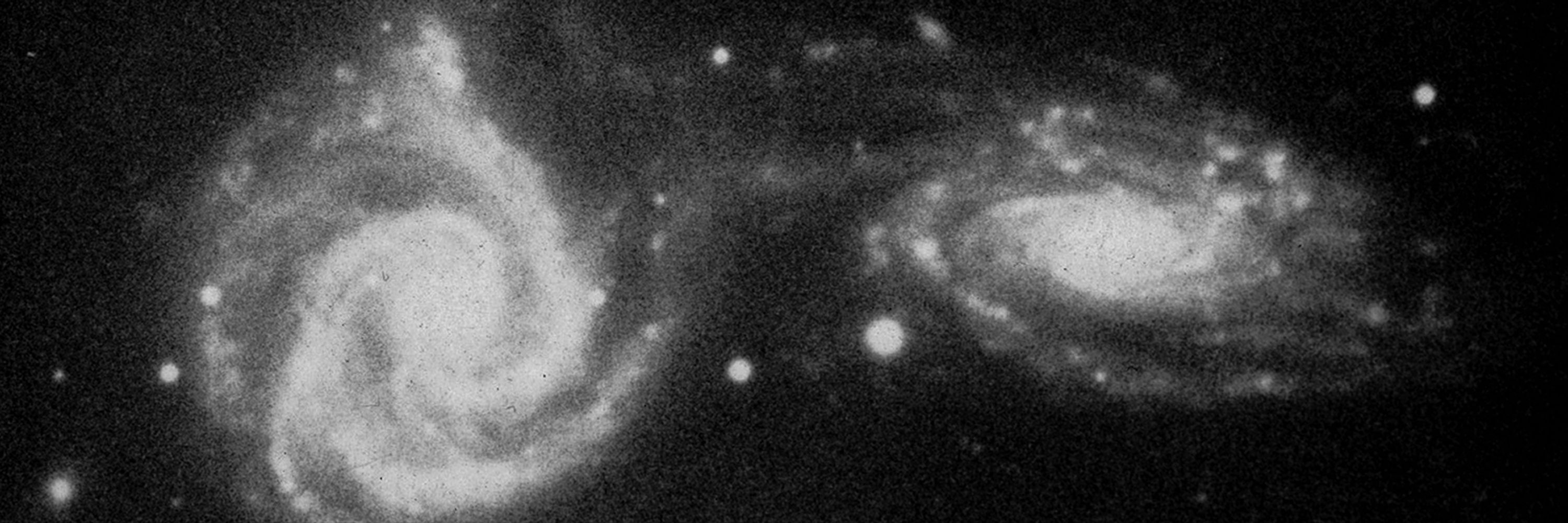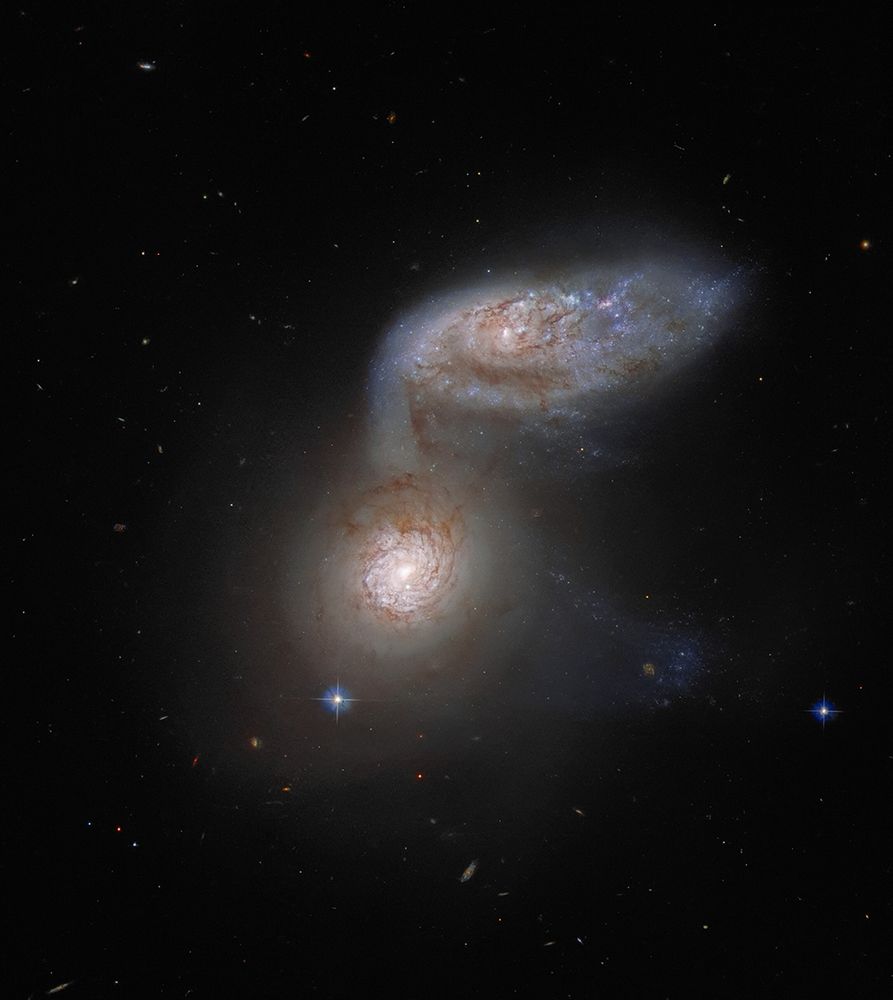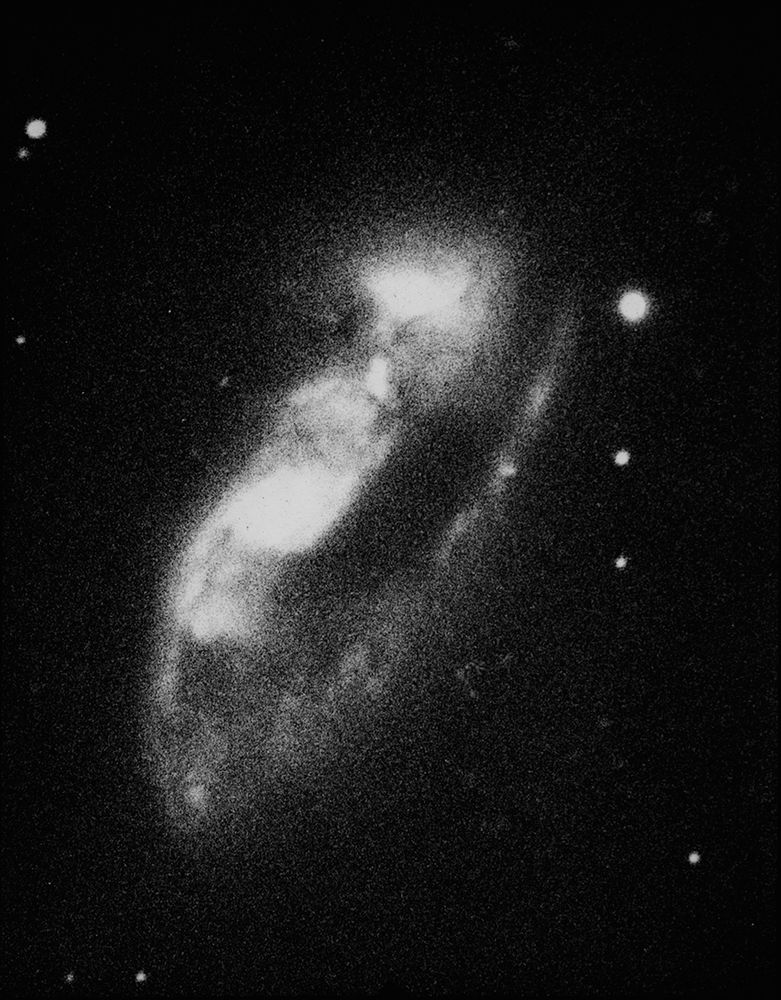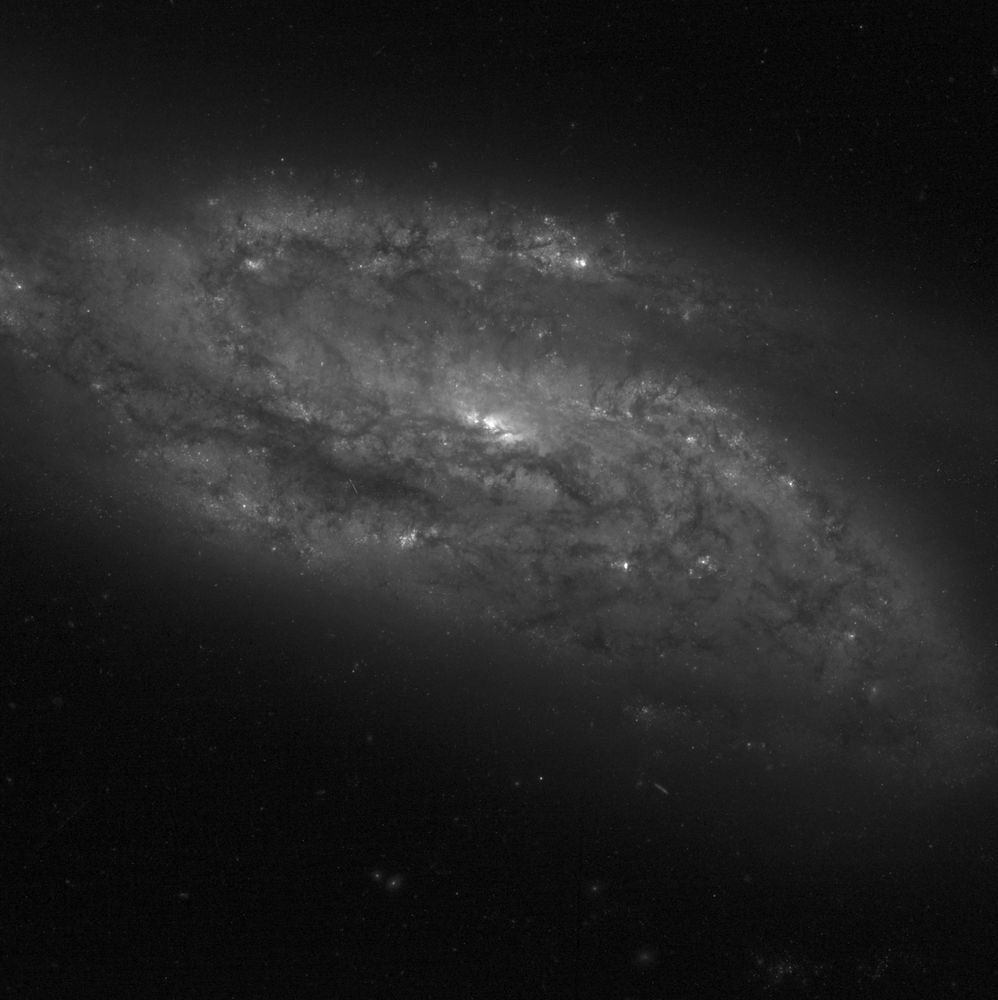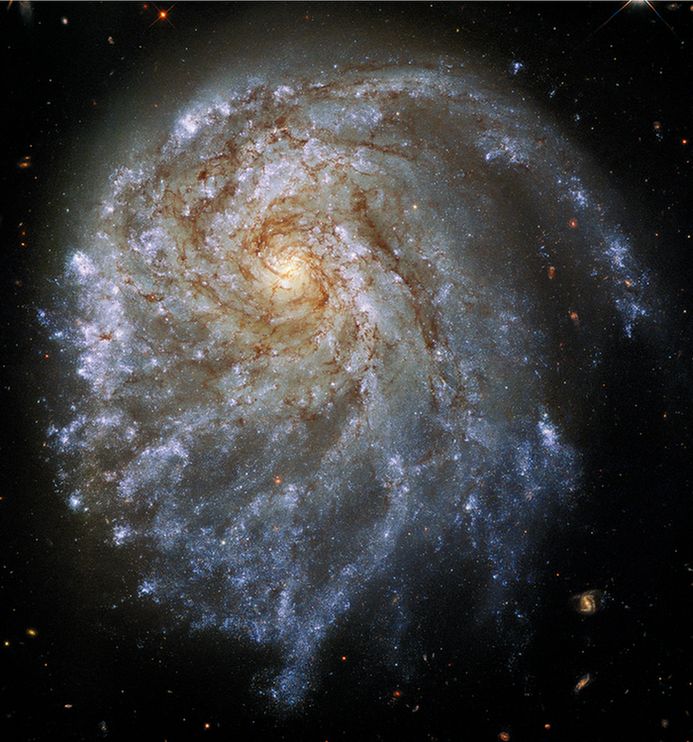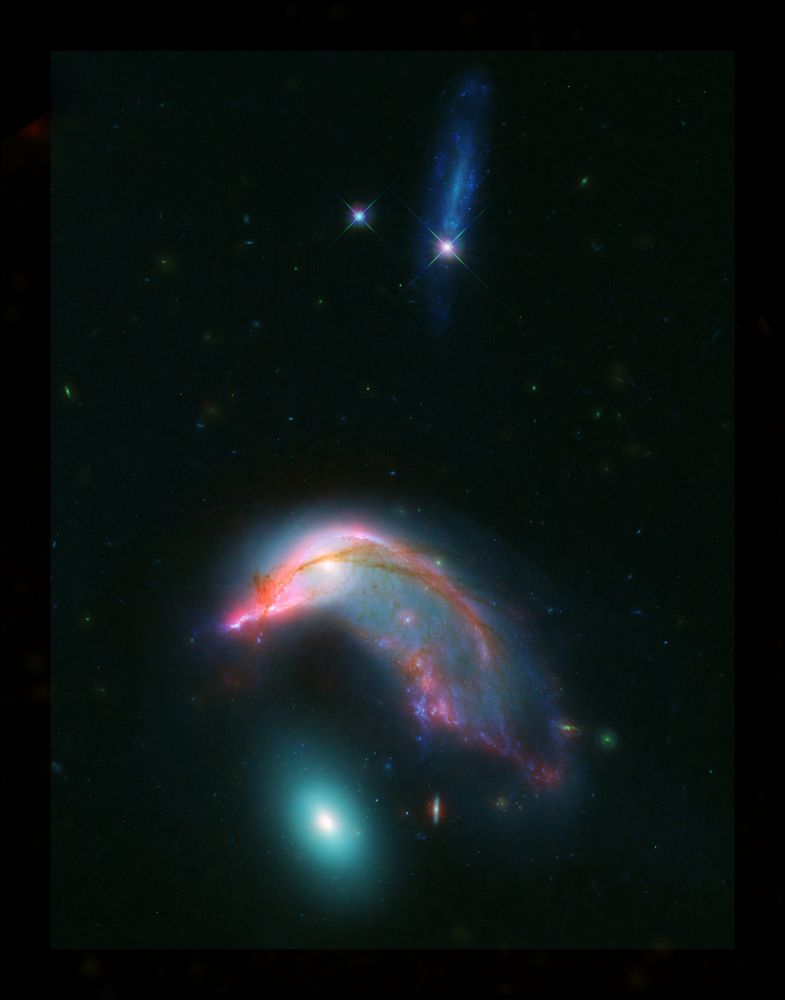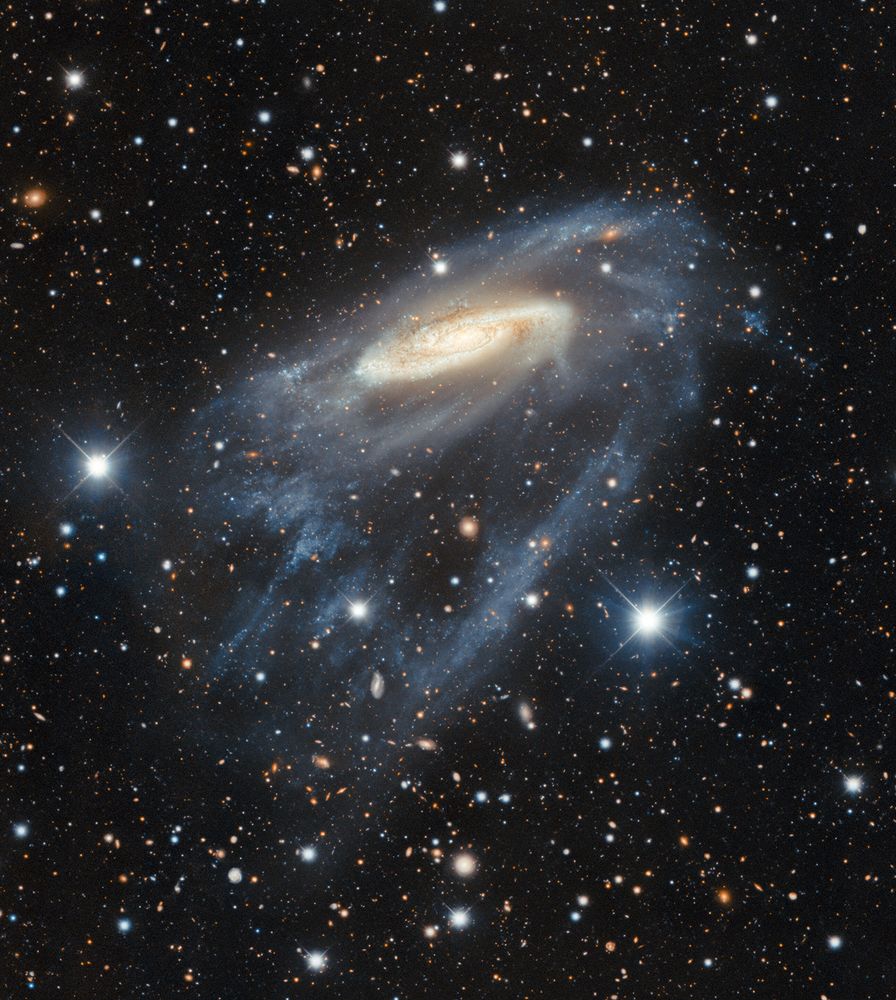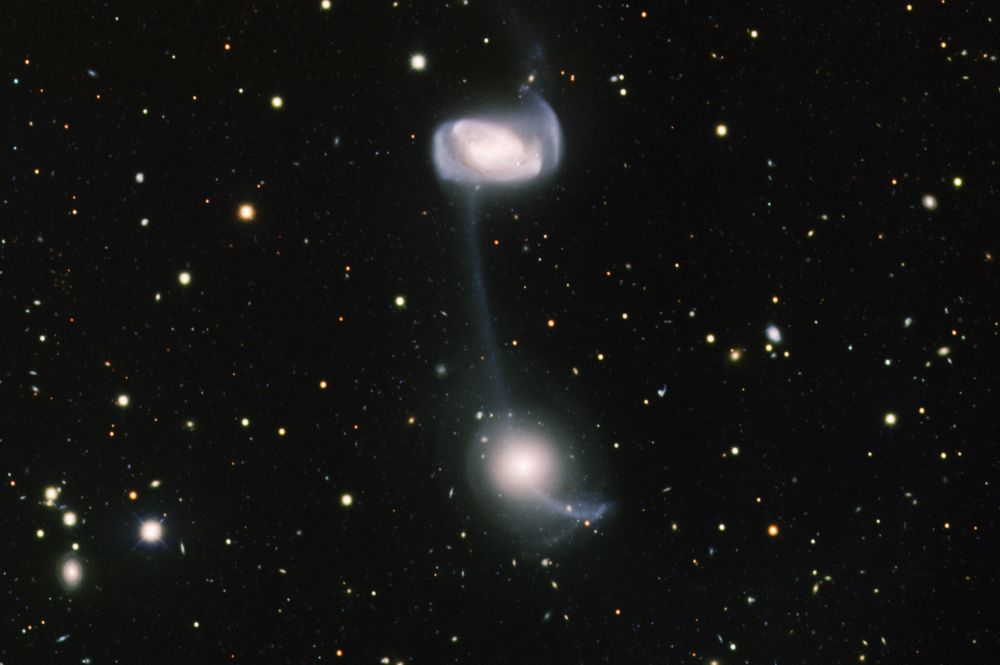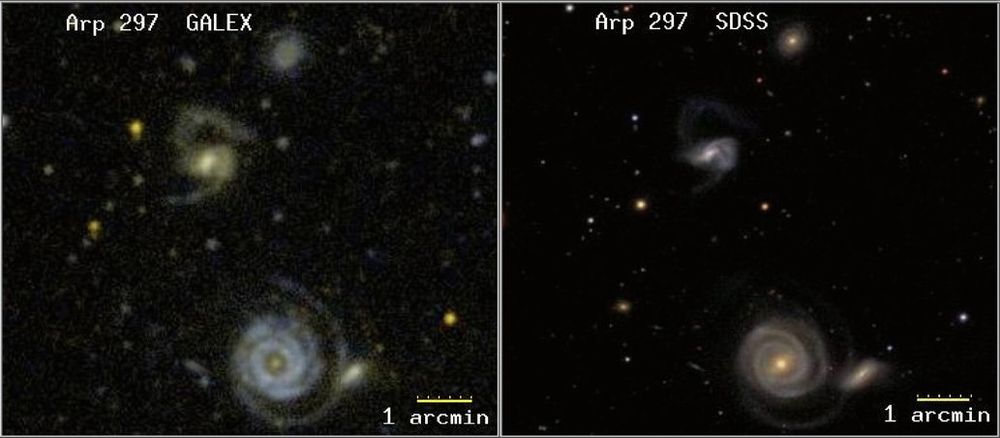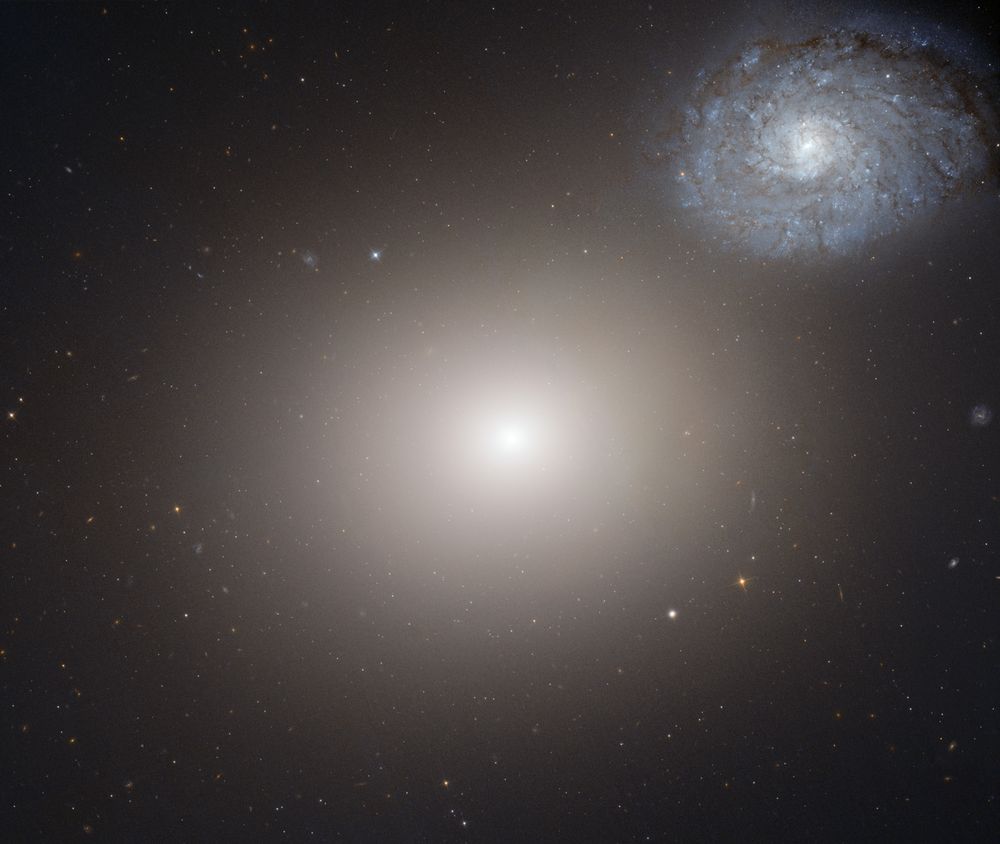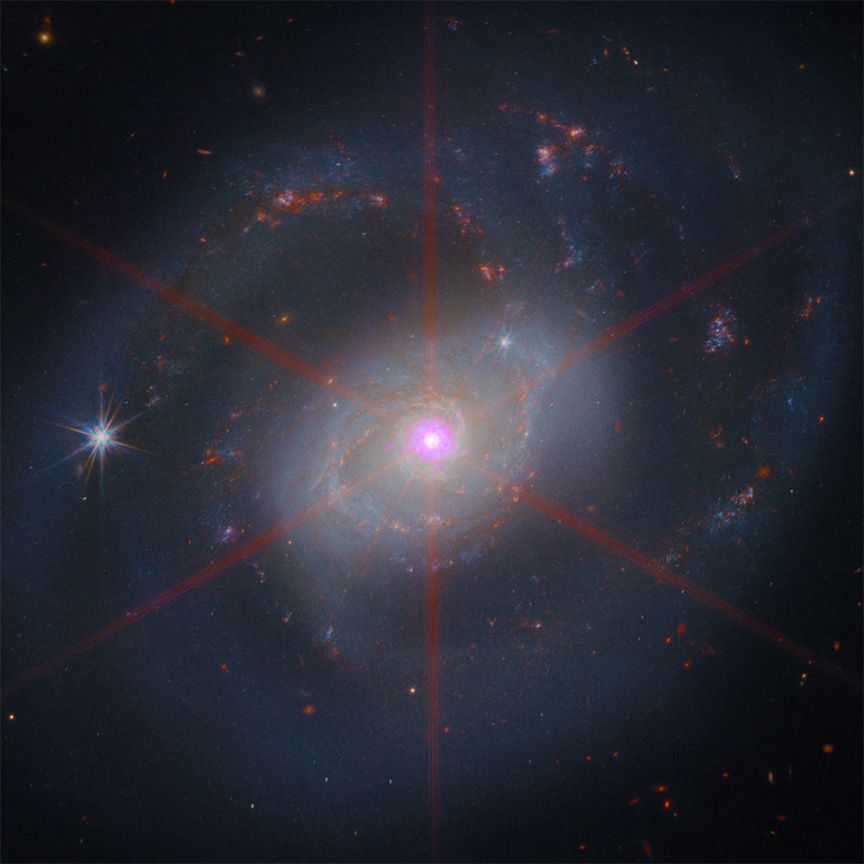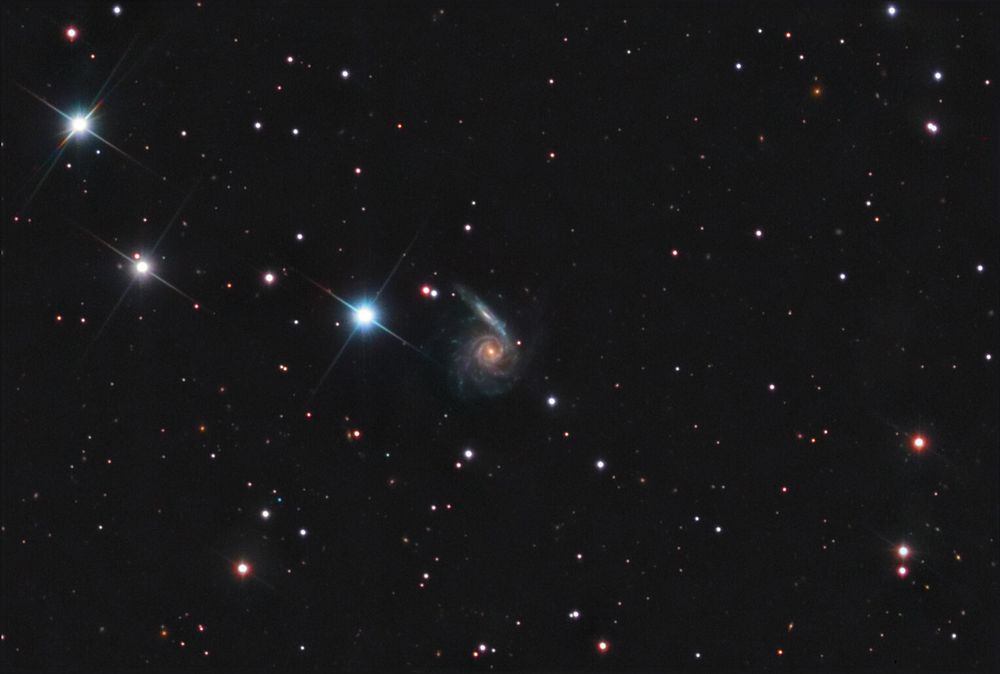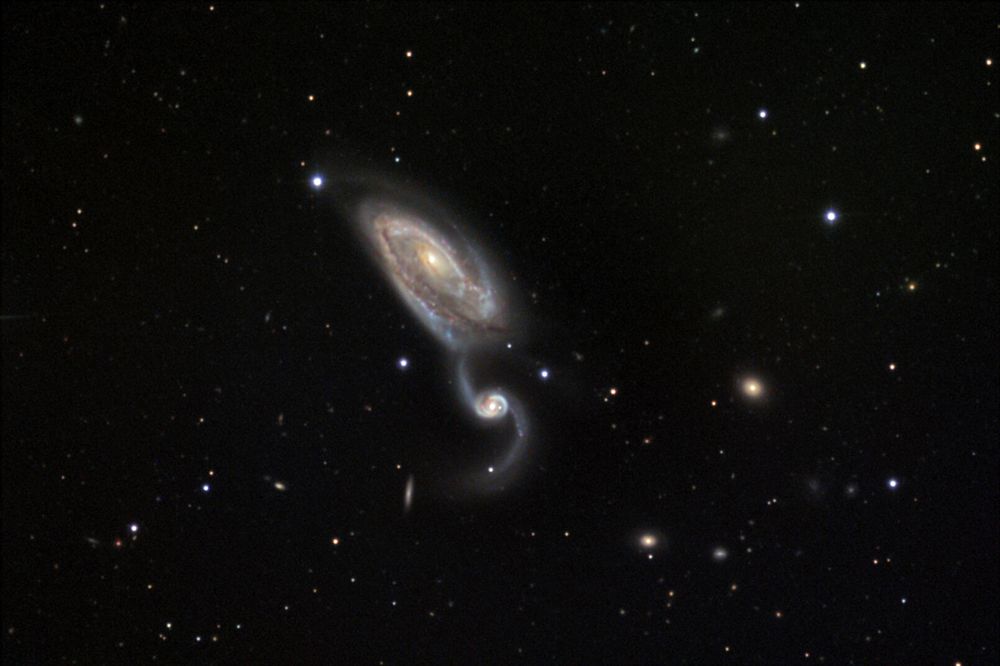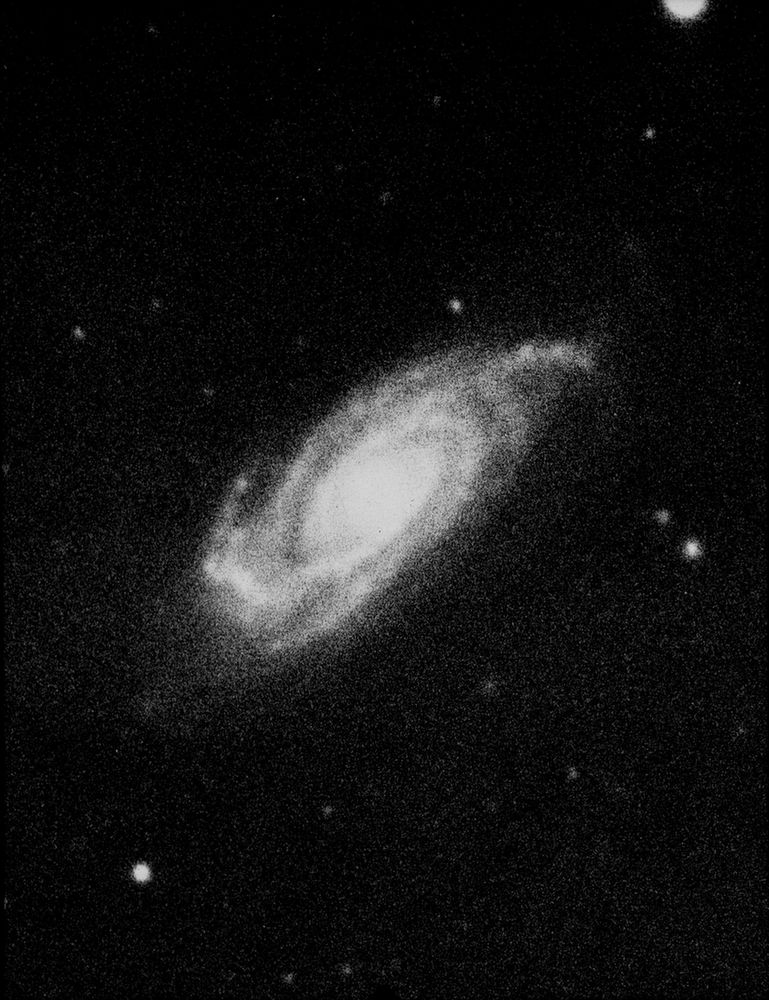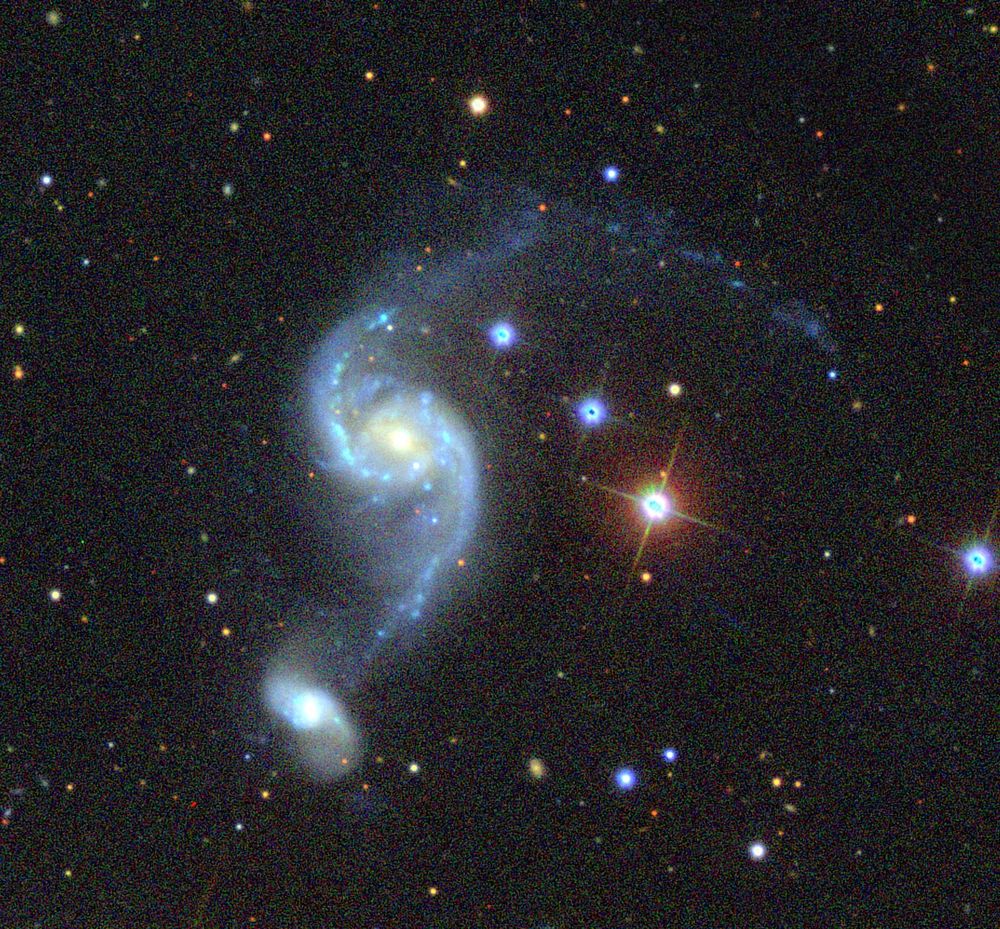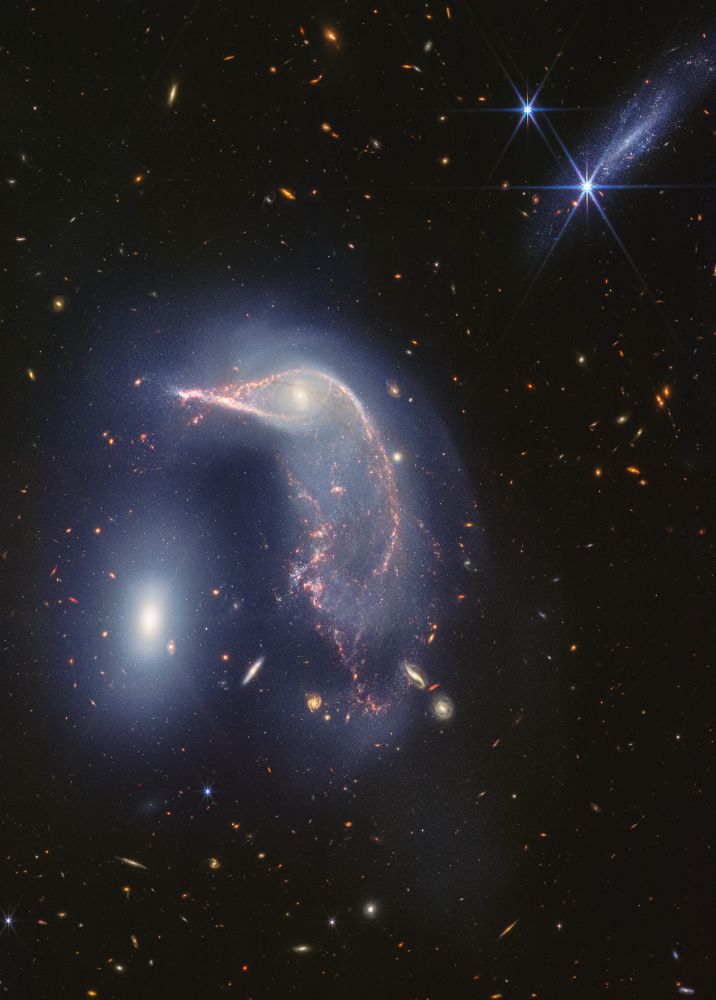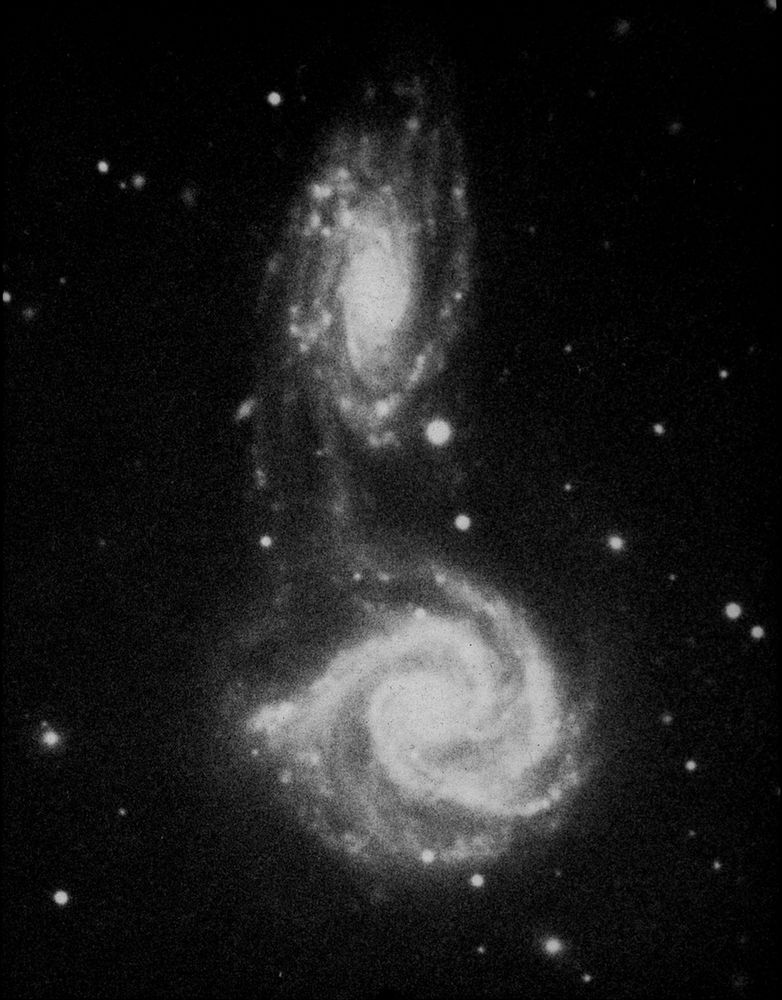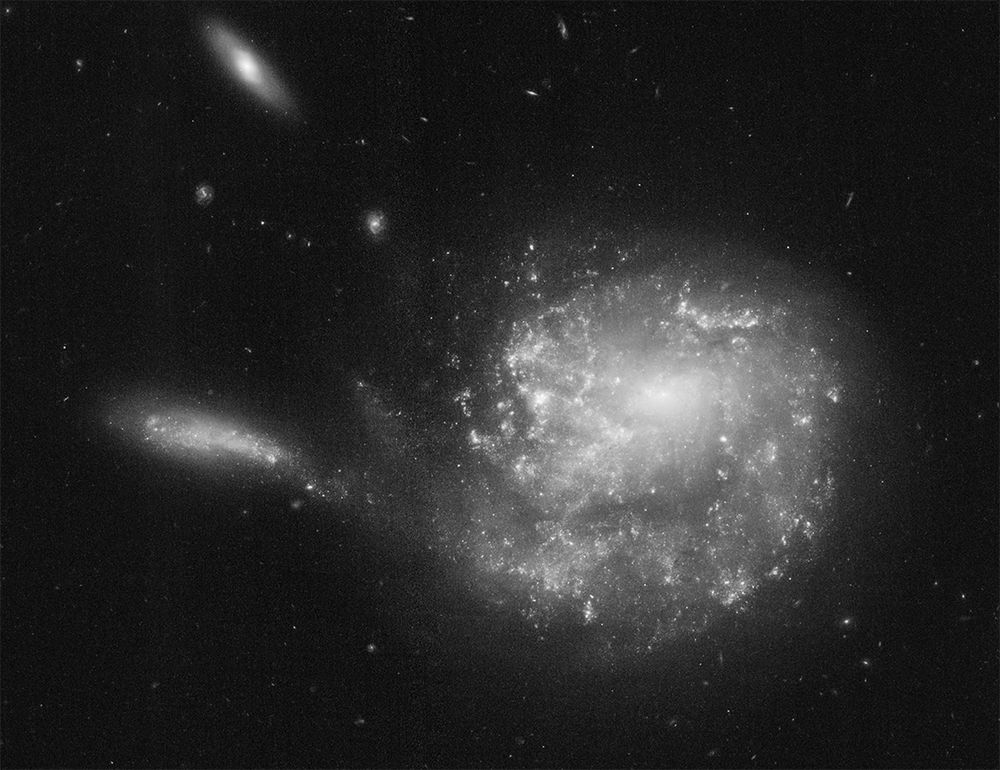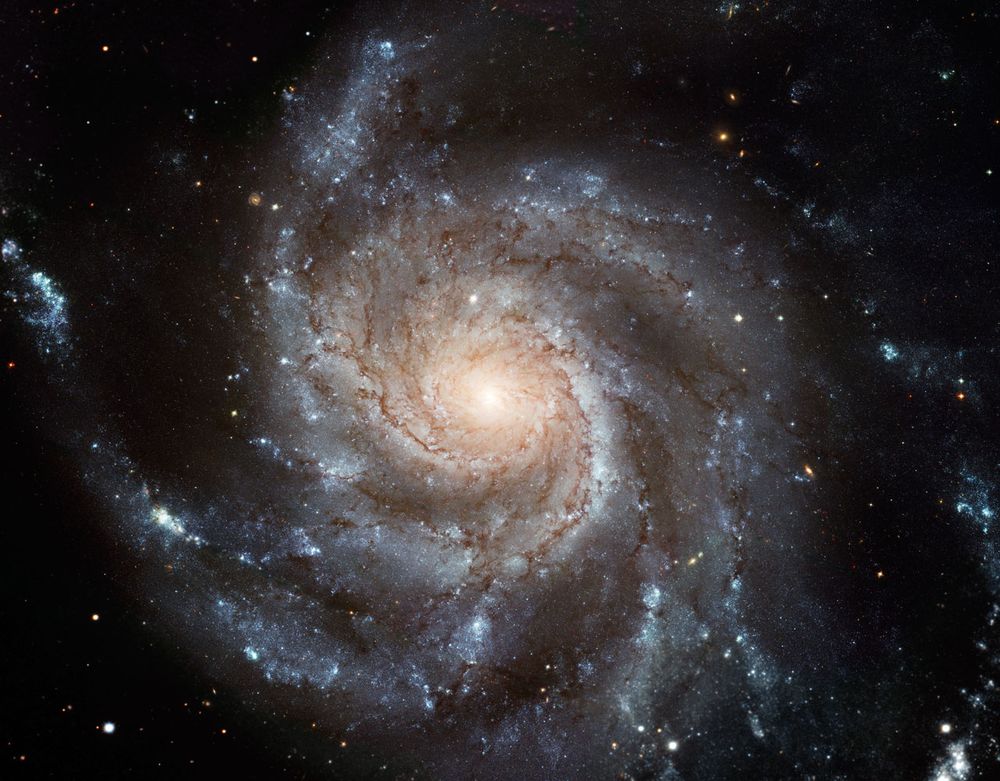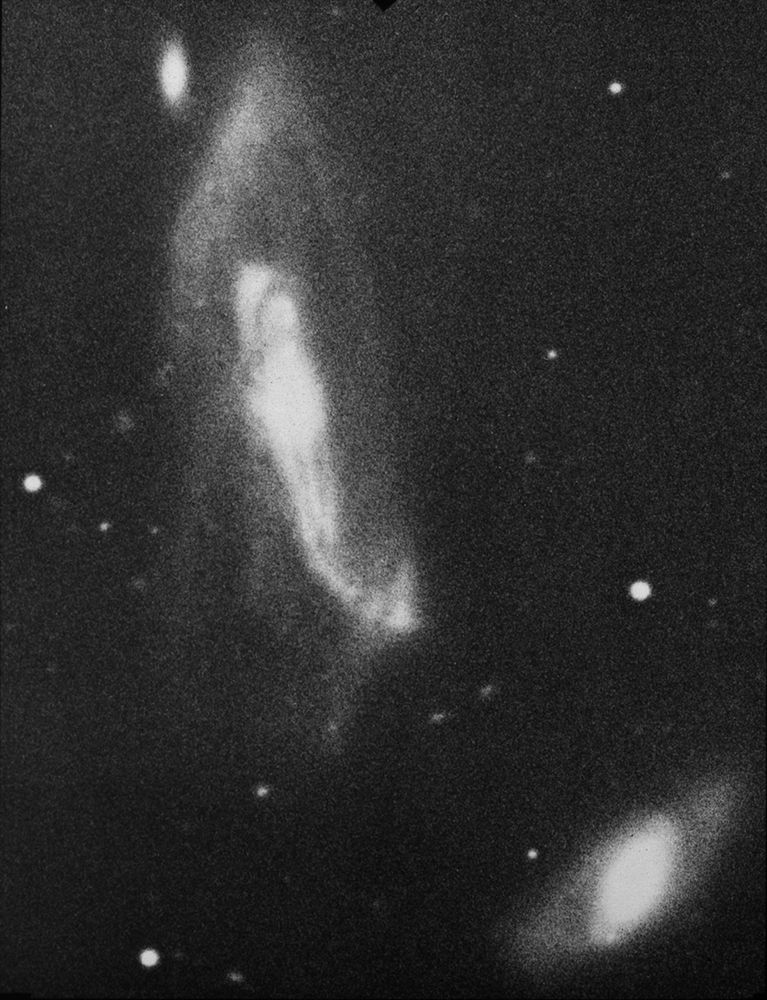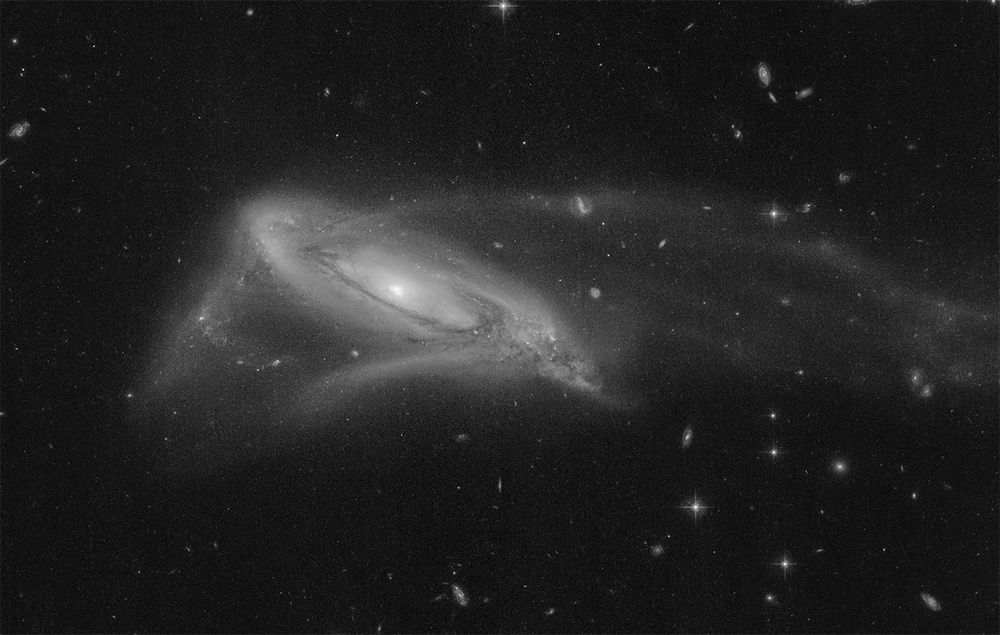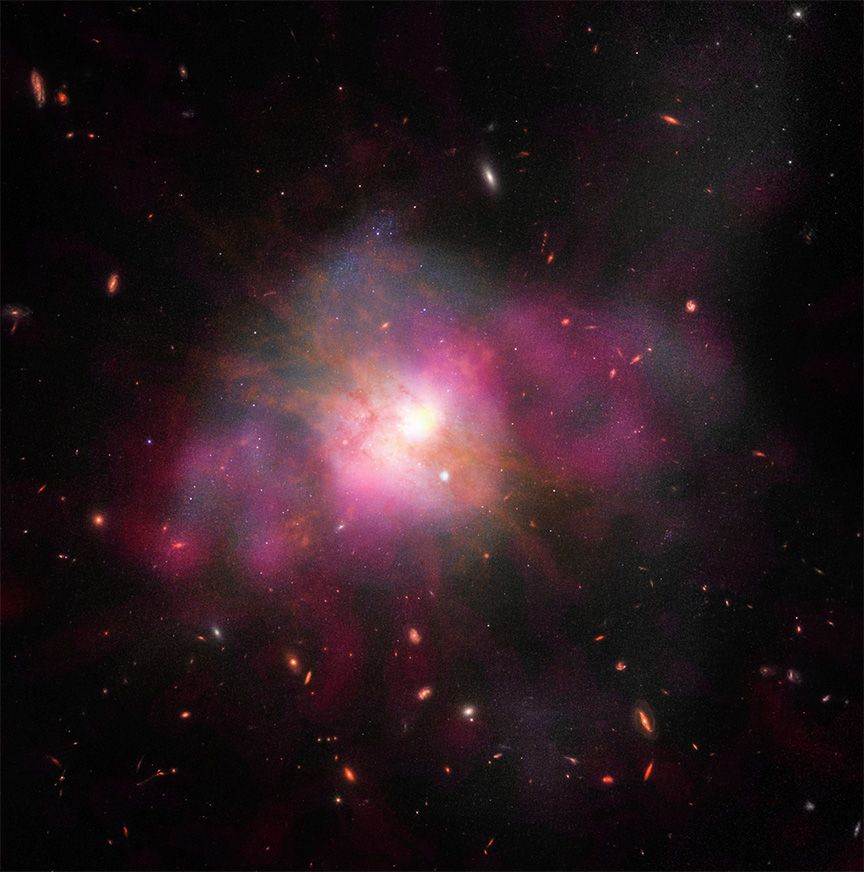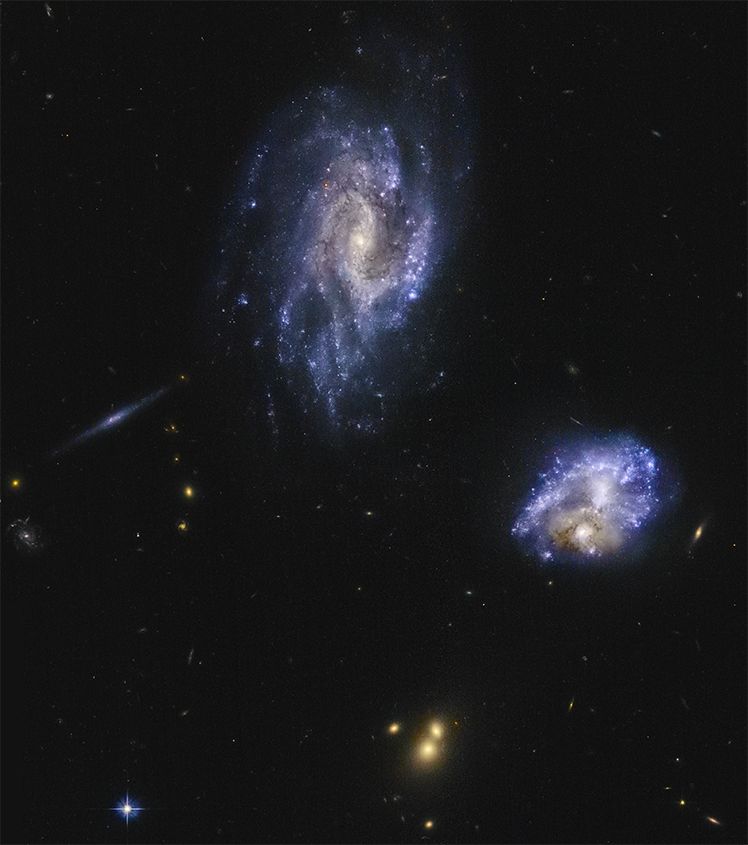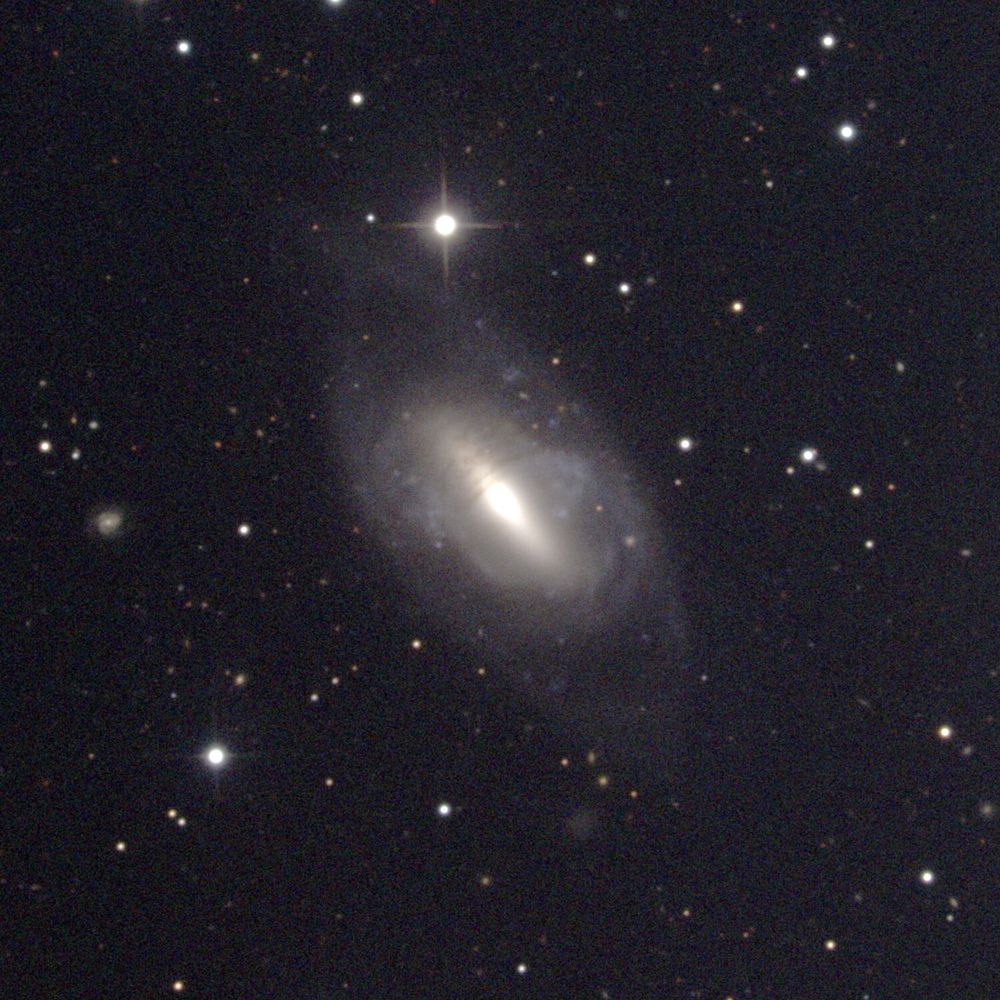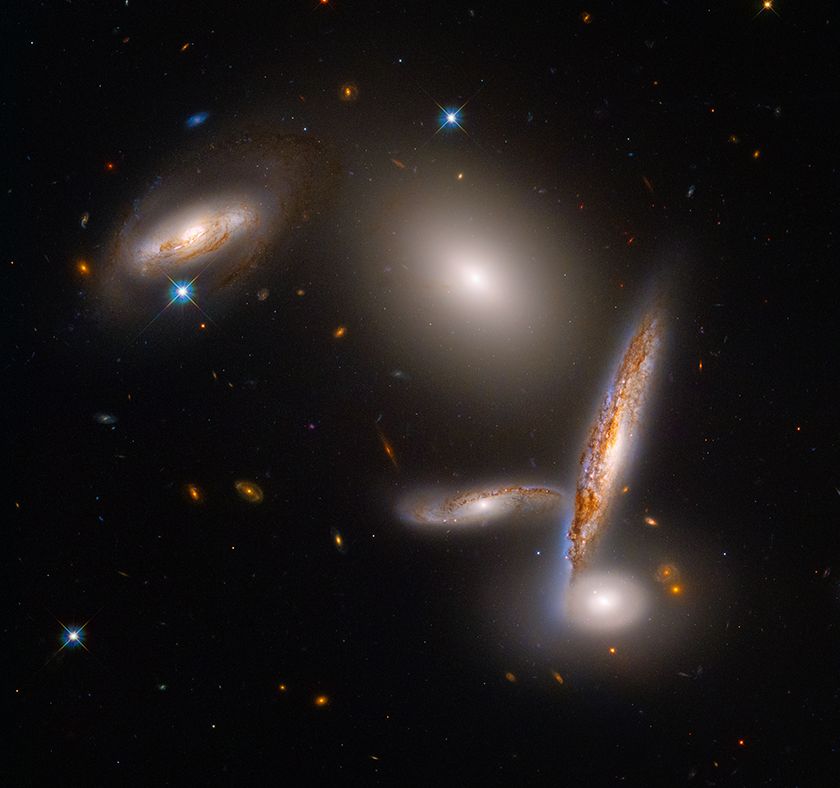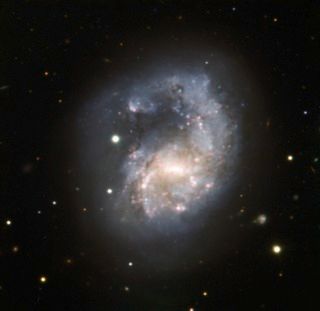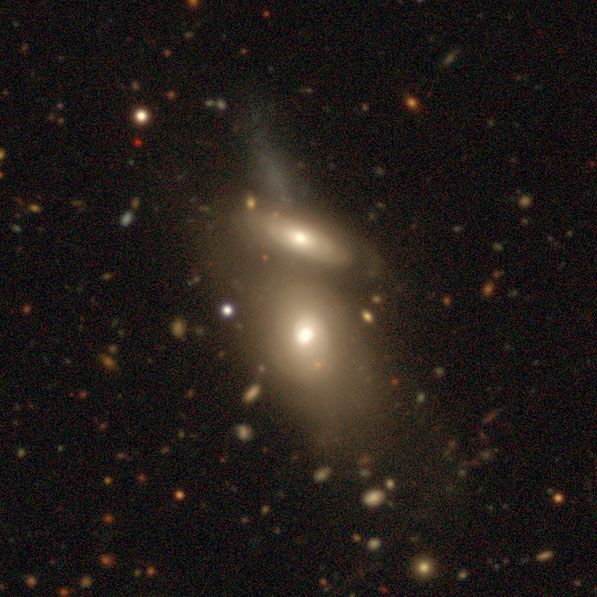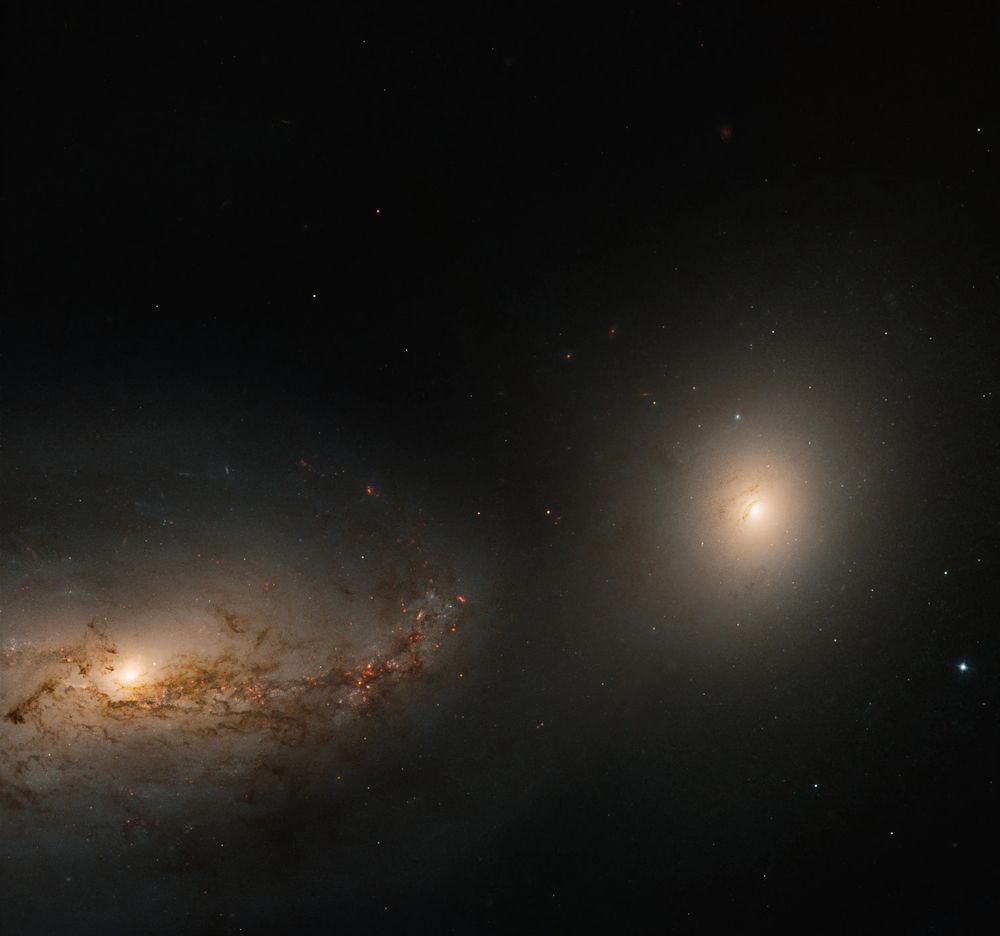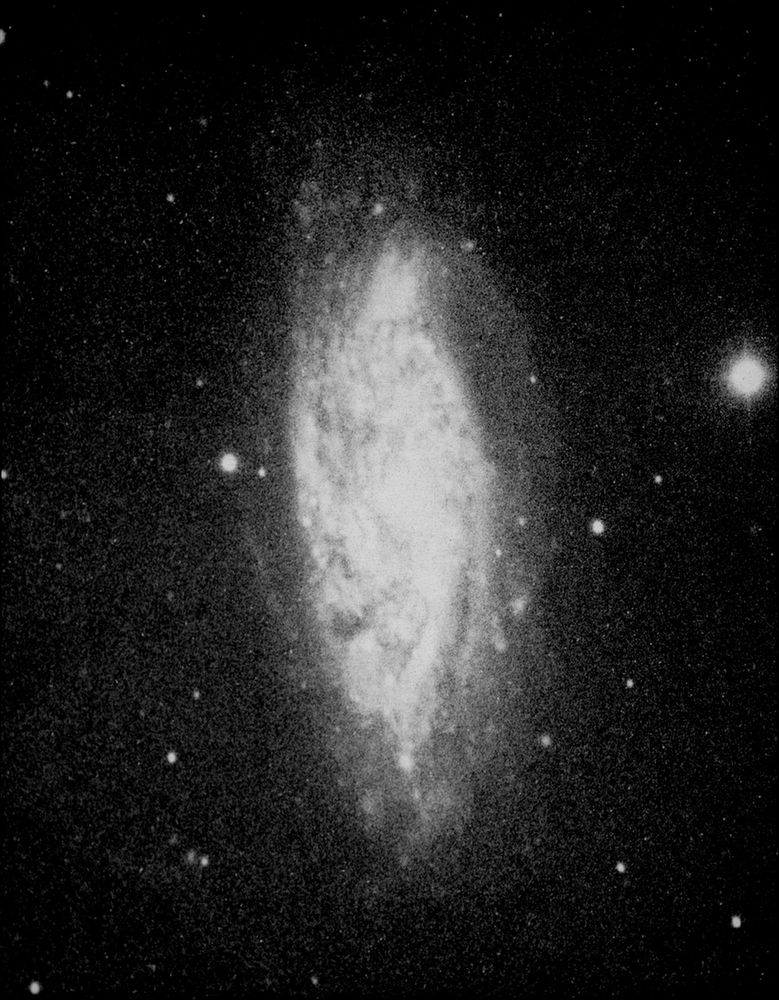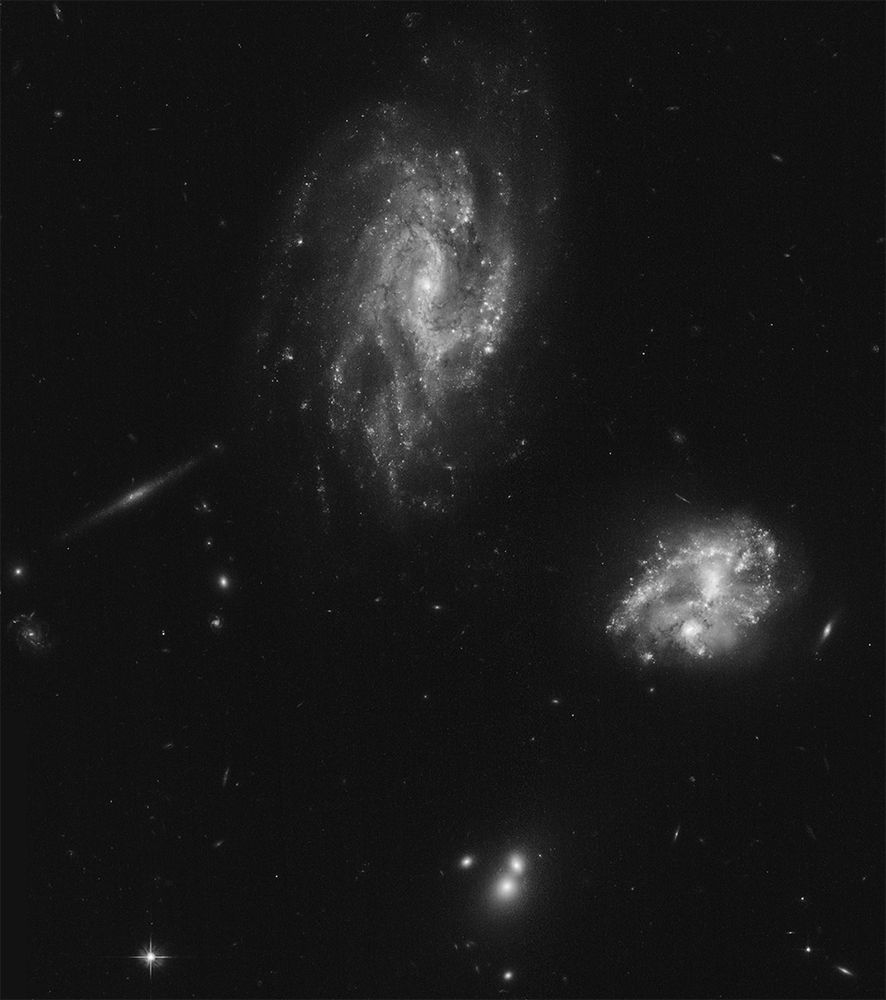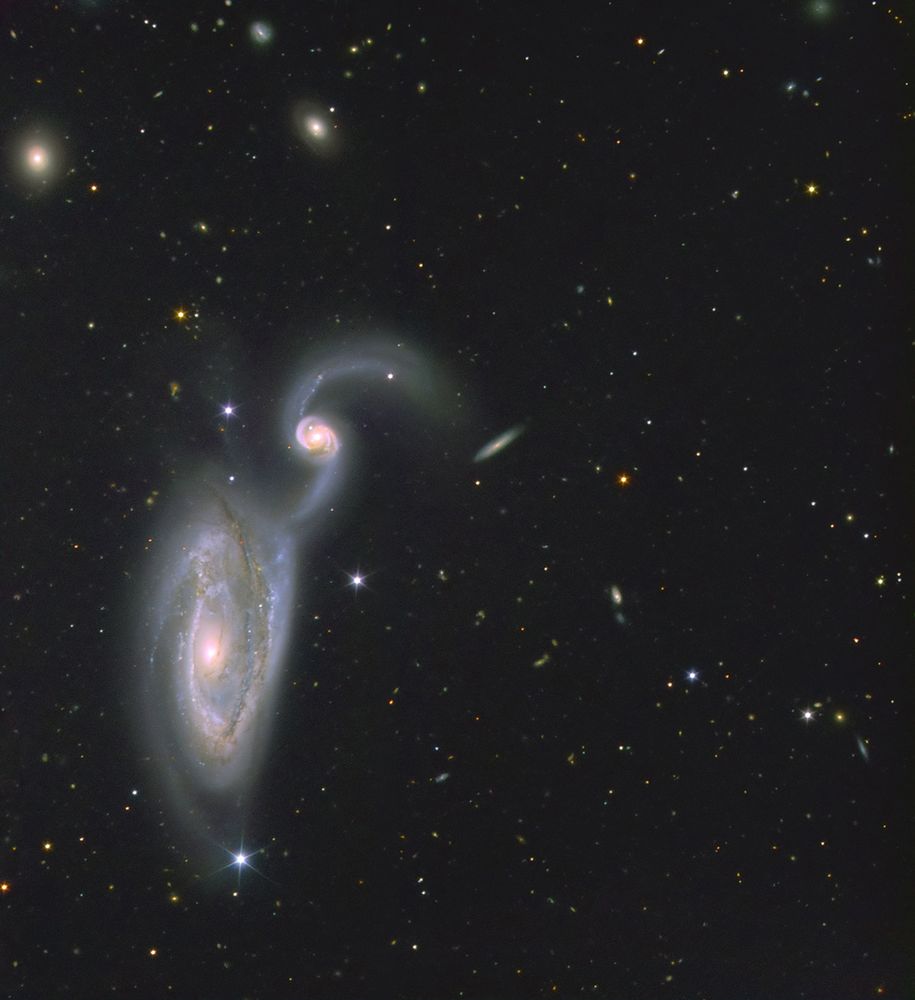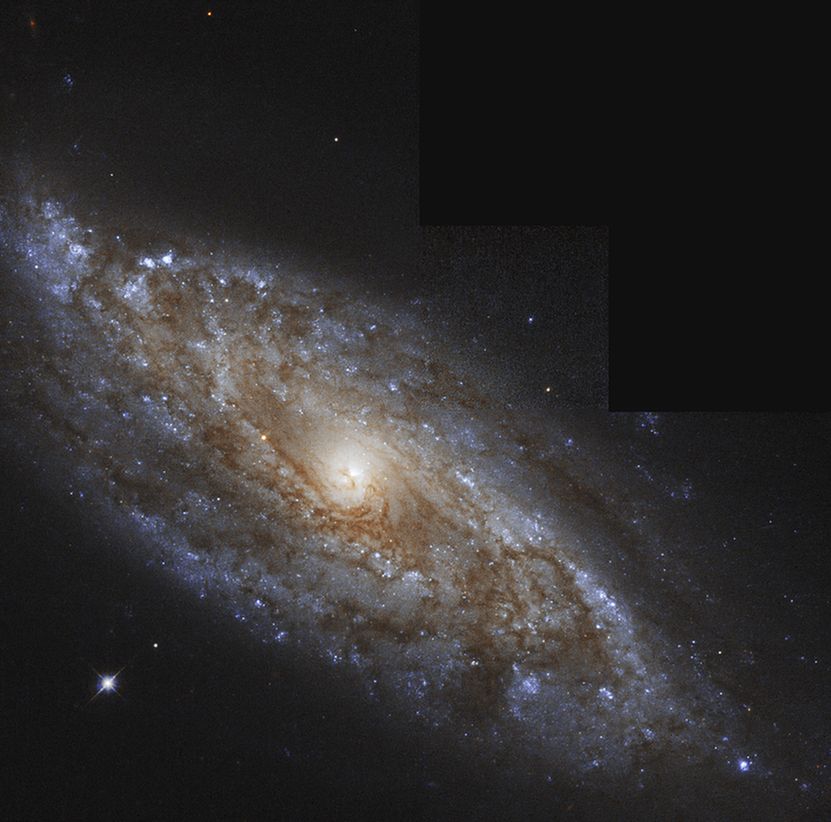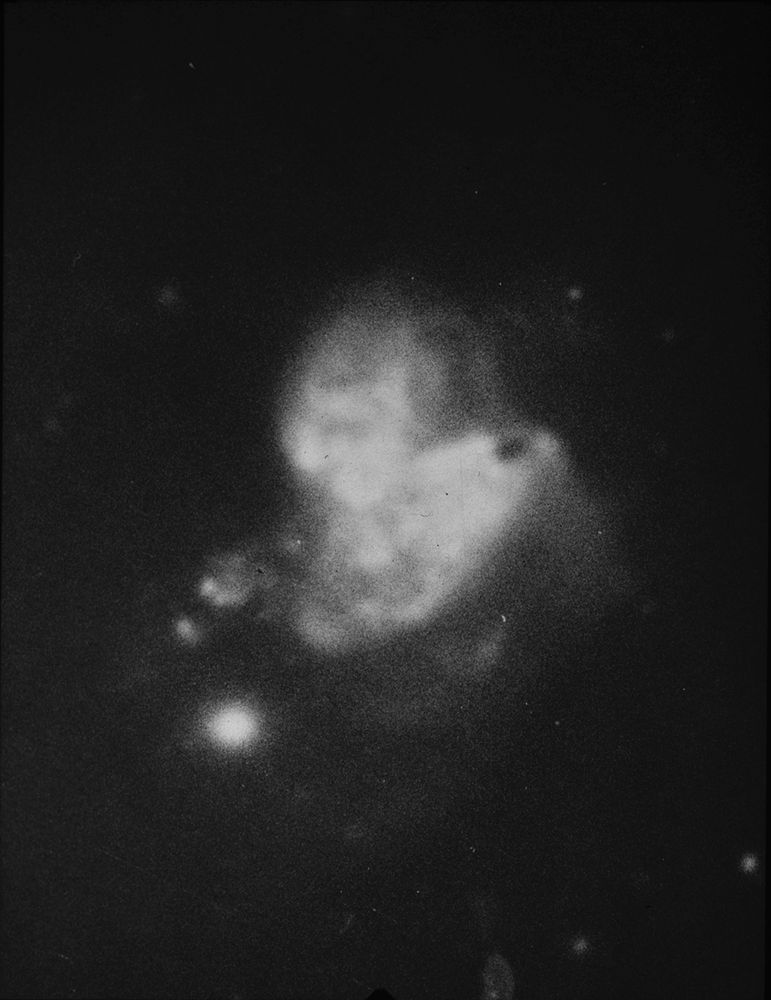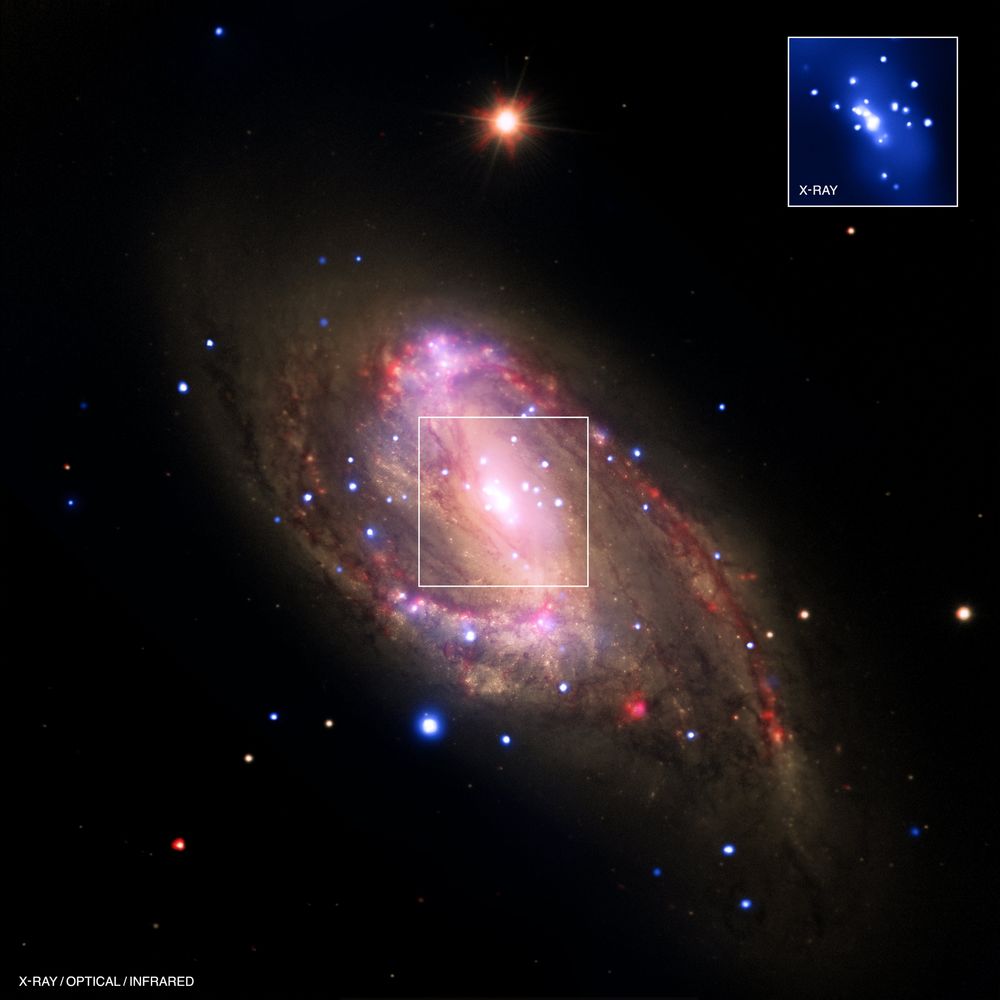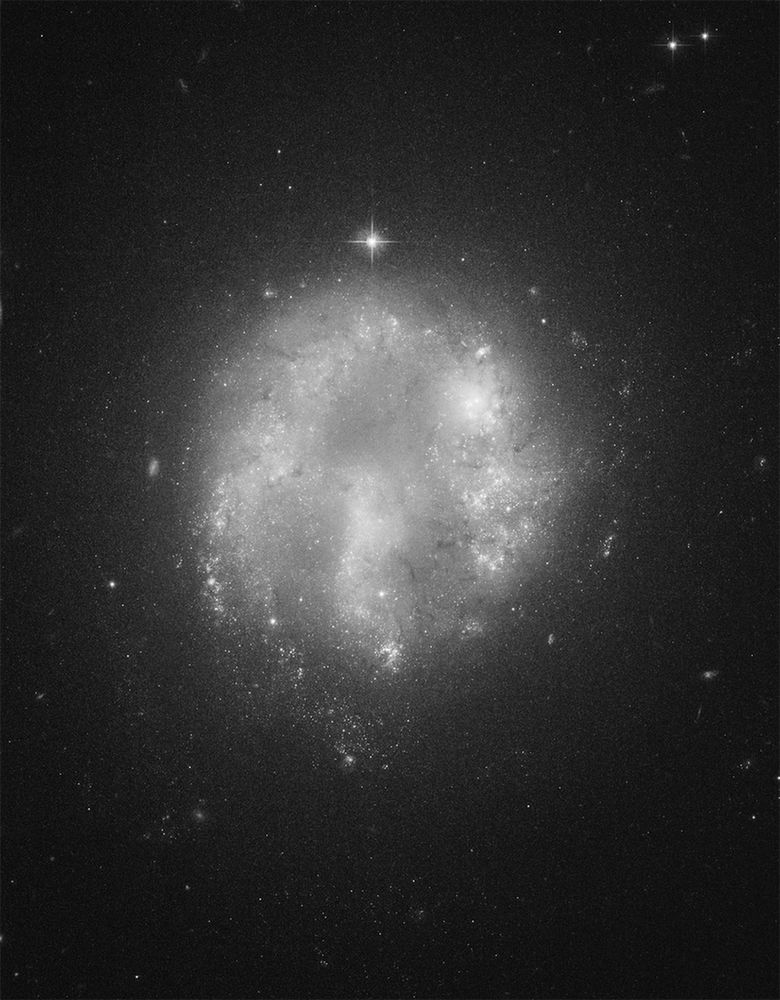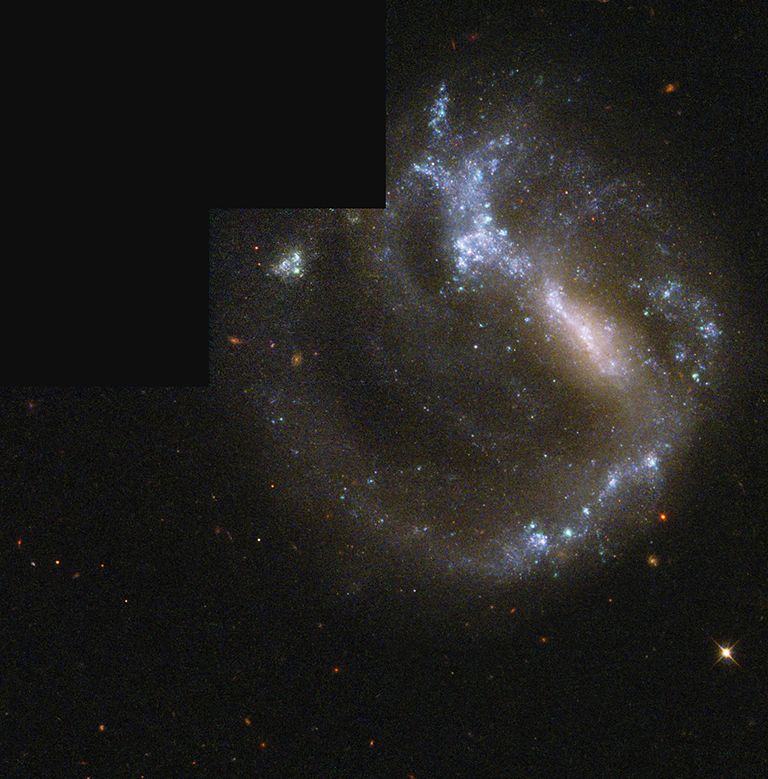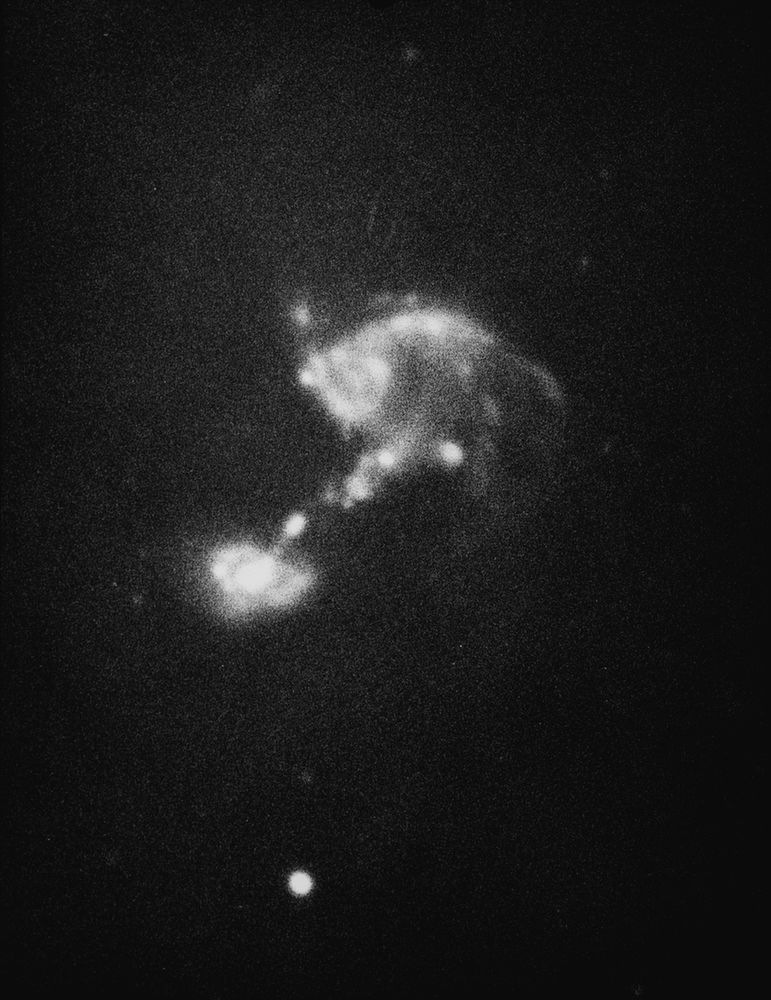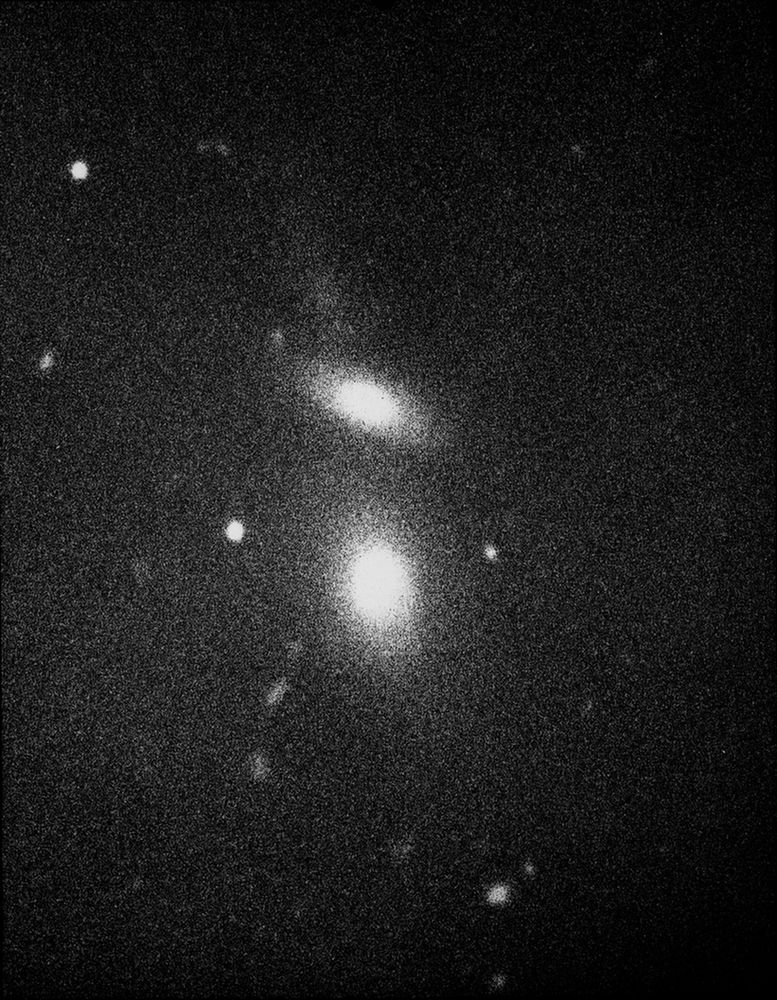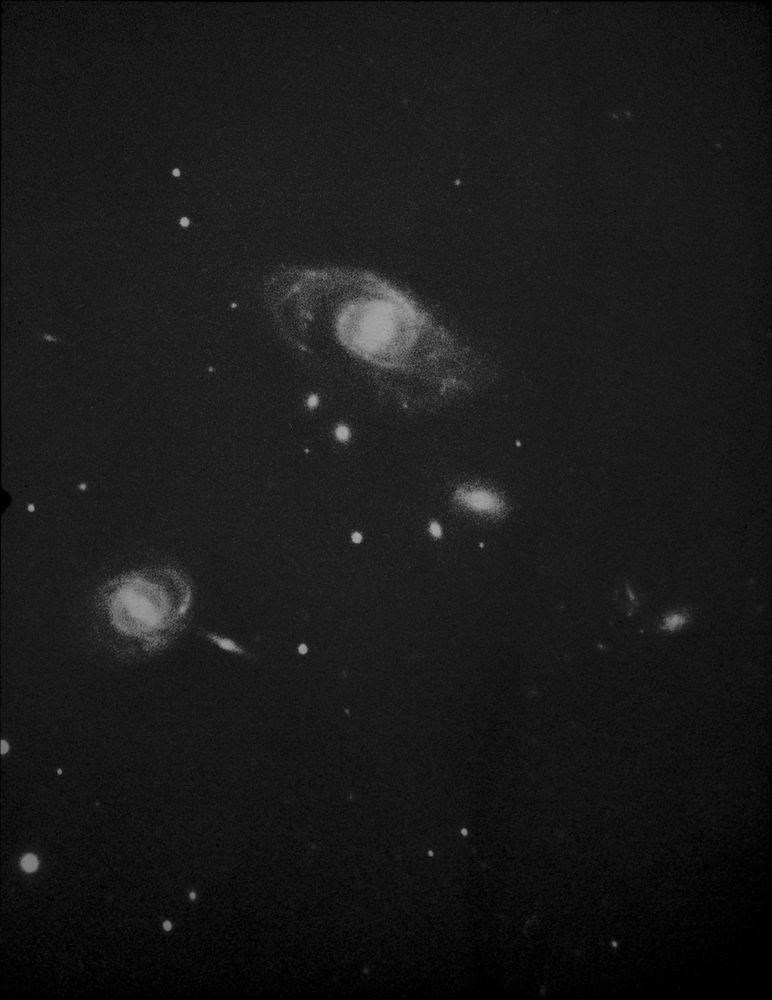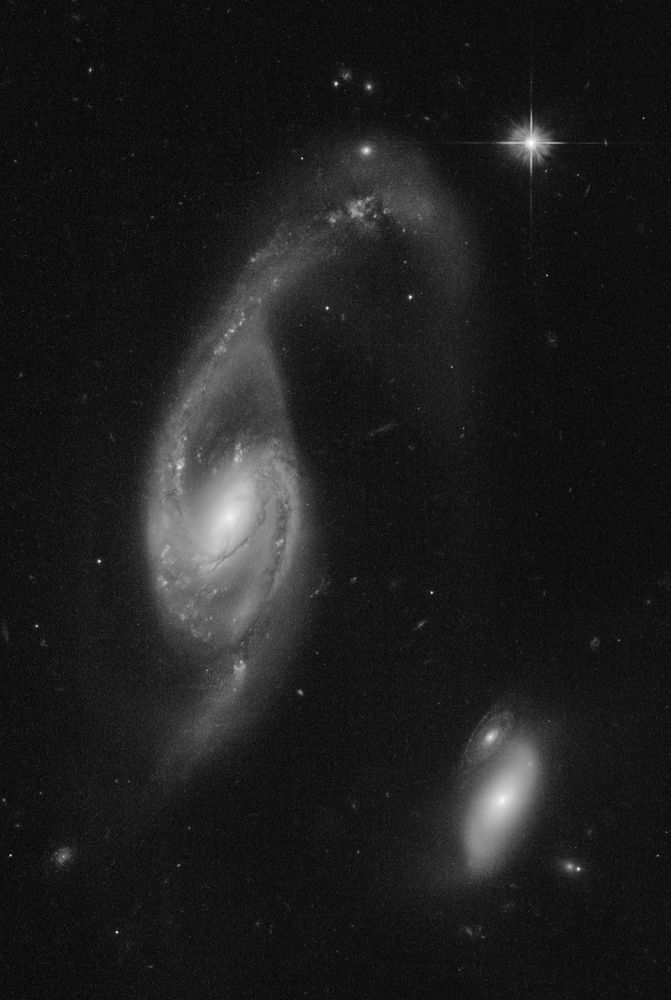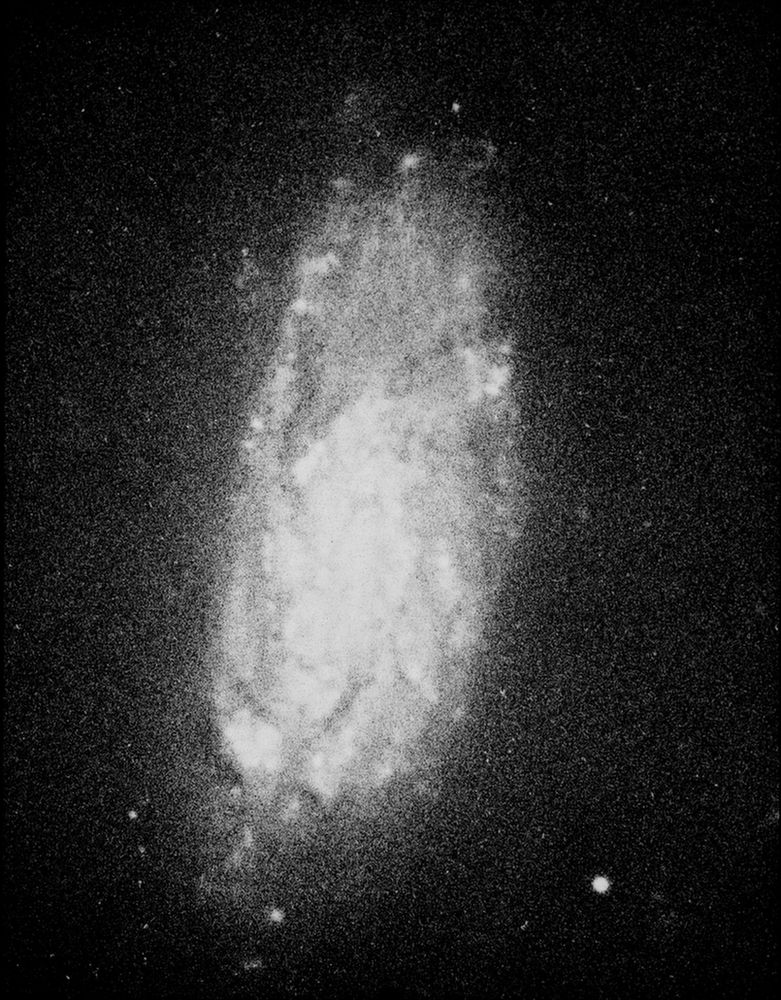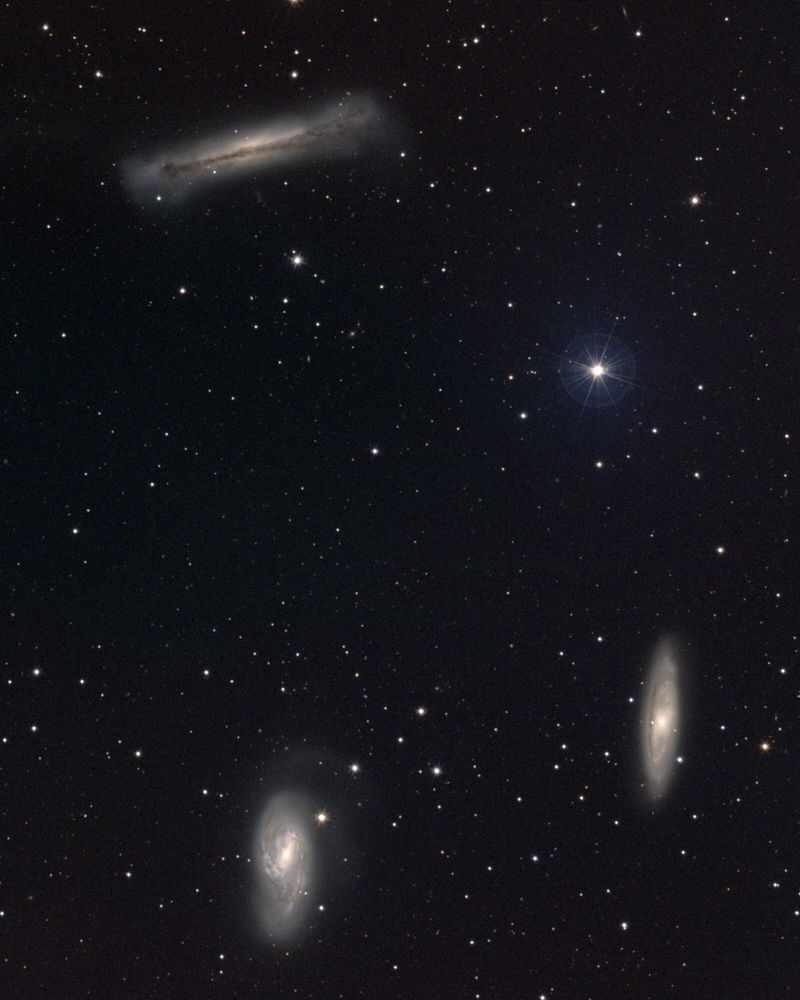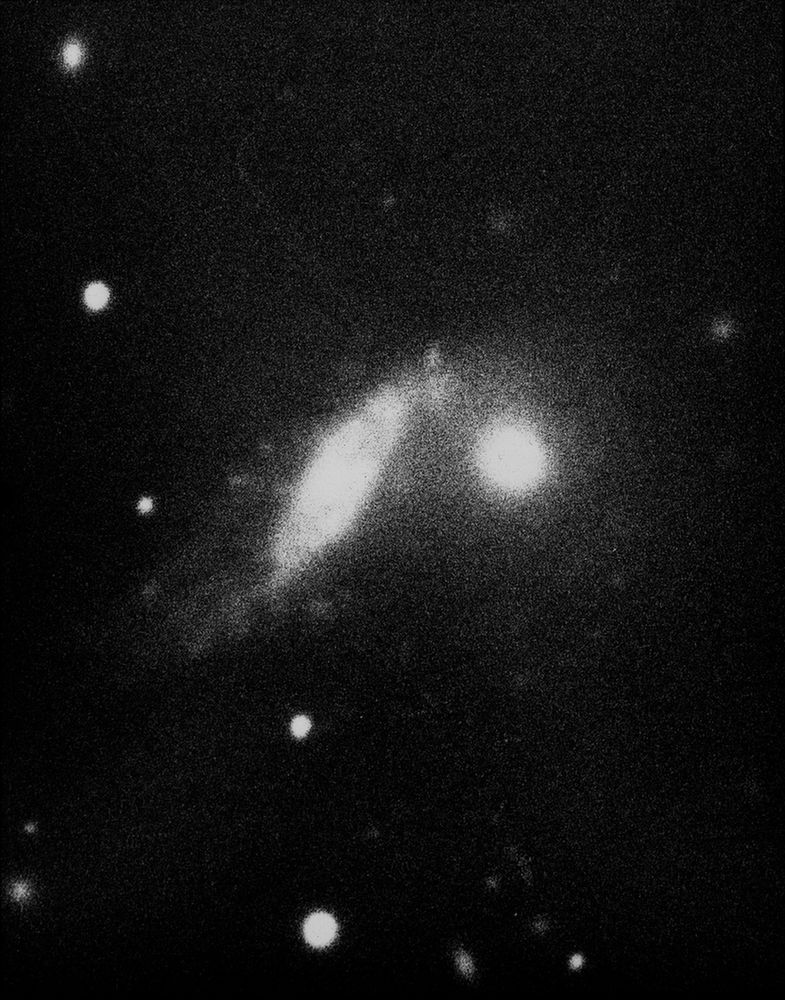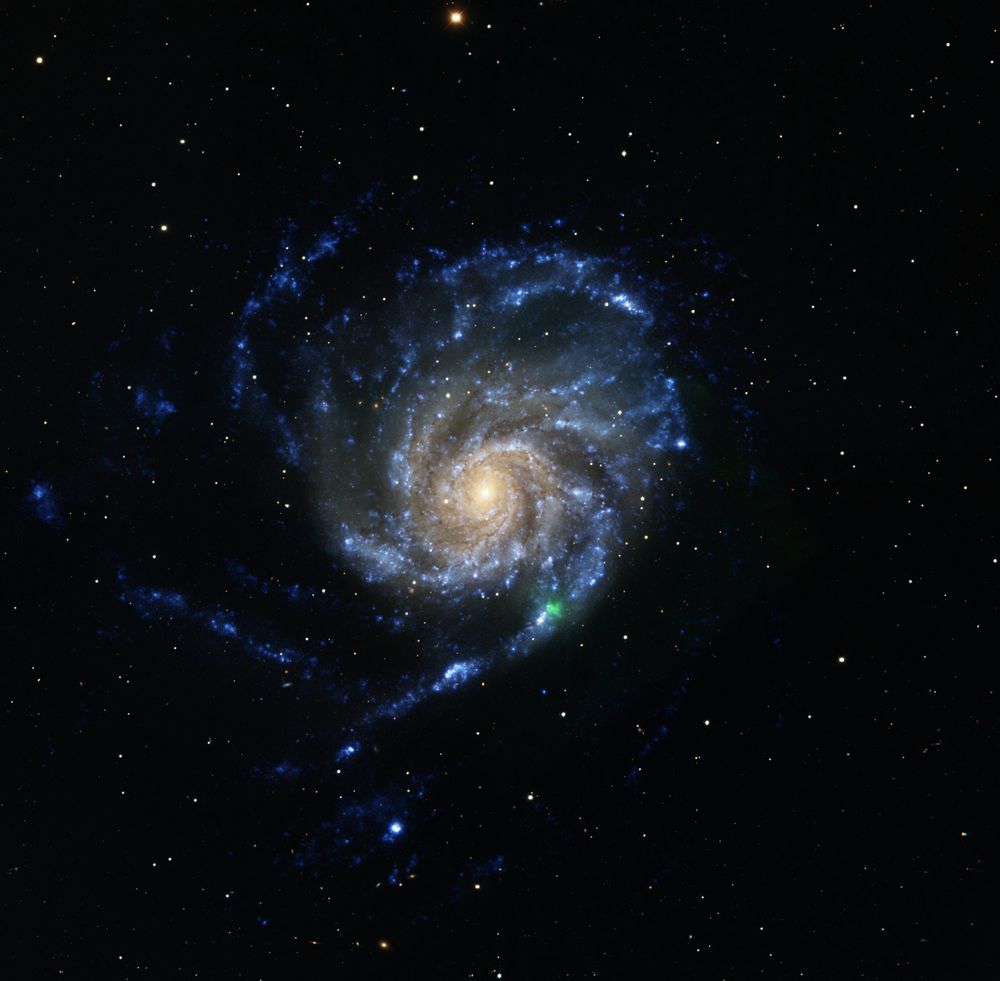Arp Bot 🤖
Posting images of galaxies in Halton Arp's Atlas of Peculiar Galaxies (1966).
Automated account. Image curation, descriptions, typos, and most alt text by astronomer @kellylepo.bsky.social.
See posts for credits and links to the original sources.
- Image of Arp 188, also known as Tadpole Galaxy, from Halton Arp's Atlas of Peculiar Galaxies (1966). In the original catalog it was in the category: Amorphous galaxies - Narrow filament. The tail is a result of a recent galactic interaction. Source
- Hubble image of Arp 91, also known as NGC 5953 and NGC 5954. NGC 5953 (center) and NGC 5954 (top) show clear signs of interaction. A spiral arm or tidal tail from NGC 5954 extends to the side and connects to its companion. Credit: ESA, NASA, J. Dalcanton, J. Schmidt Source
- Image of Arp 81, also known as NGC 6621 and NGC 6622, from Halton Arp's Atlas of Peculiar Galaxies (1966). In the original catalog it was in the category: Spiral galaxies - Large, high surface brightness companions. Source
- Hubble Space Telescope image of Arp 18, also known as NGC 4088. NGC 4088 is an asymmetric spiral galaxy, located about 40 million light years away. Credit: NASA, ESA, STScI, Julianne Dalcanton, Meli thev, Wikimedia Commons Source
- Hubble Space Telescope image of Arp 25, also known as NGC 2276. The lopsided galaxy has a core offset to the upper left and a spiral arm separated from the others. It is interacting with a nearby galaxy, just out of frame. Credit: NASA, ESA, STScI, P. Sell Source
- Spitzer and Hubble image of Arp 142, also known as NGC 2936, NGC 2937, and UGC 5130, or the Penguin and the Egg. Dust and gas in the Penguin appear as red filaments. The Egg is made of older stars and nearly featureless. Credit: NASA, ESA, STScI, AURA, JPL-Caltech Source
- Dark Energy Camera image of Arp 289, also known as NGC 3981. The galaxy's irregular arms is likely due to gravitational interactions with a neighboring galaxy. Credit: Dark Energy Survey, DOE, FNAL, DECam, CTIO, NOIRLab, NSF, AURA, R. Colombari, M. Zamani Source
- Image of Arp 94, also known as NGC 3226 and NGC 3227, from Halton Arp's Atlas of Peculiar Galaxies (1966). In the original catalog it was in the category: Spiral galaxies - Elliptical companions. Spiral NGC 3227 interacts with elliptical NGC 3226. Source
- Kitt Peak National Observatory image of Arp 104, also known as NGC 5216 and NGC 5218, or Keenan’s System. A bridge of stars and gas about 7,000 light years wide and 150,000 light years long connects the two galaxies. Credit: NOIRLab, NSF, AURA, T.A. Rector, H. Schweiker Source
- GALEX and SDSS image of Arp 297, also known as NGC 5755, NGC 5753, NGC 5754 and NGC 5752. The left image is in ultraviolet light. The right image is in visible light. The upper and lower galaxy pairs are at different distances. Credit: Fig. 13 from Smith et al. 2010. Source
- Hubble image of Arp 116, also known as M60 and NGC 4647. M60 is a giant elliptical galaxy. The smaller spiral NGC 4647 is about the size of our galaxy, the Milky Way. While it is not obvious, the two galaxies are just beginning to interact. Credit: NASA, ESA, STScI Source
- Composite image of Arp 298, also known as NGC 7469 and IC 5283. X-rays from Chandra (purple) are overlaid on a Hubble and JWST image of NGC 7469. Credit: NASA, CXC, X. Xu; NASA, ESA, UVA, NRAO, A. S. Evans, Hubble Heritage team; NASA, ESA, CSA, L. Armus, A. S. Evans; J. Major Source
- Kitt Peak image of Arp 30, also known as NGC 6365. Arp thought this was one galaxy with a particularly beefy arm. Later images show this is actually a pair of galaxies, one face-on and one nearly edge-on. Credit: KPNO, NOIRLab, NSF, AURA, Friends' Central School, A. Block Source
- Kitt Peak image of Arp 84, also known as NGC 5394 and NGC 5395. Interactions between the galaxy pair funneled gas into the center of NGC 5394, the smaller spiral, providing the raw materials for new stars. Credit: KPNO, NOIRLab, NSF, AURA, D. Matthews, E. J. Jones, A. Block Source
- Image of Arp 8, also known as NGC 497, from Halton Arp's Atlas of Peculiar Galaxies (1966). In the original catalog it was in the category: Spiral galaxies - Split arms. It is a barred spiral galaxy in the constellation Cetus. Source
- SDSS image of Arp 82, also known as NGC 2535 and NGC 2536. The pair is in the early stages of a merger. The larger galaxy's arms have evenly spaced "beads on a string" clusters of young stars, created by recent gravitational interactions. Credit: SDSS Source
- JWST NIRCam image of Arp 142, also known as NGC 2936 and NGC 2937, or the Penguin and the Egg. The blue haze in the distorted spiral galaxy, elliptical galaxy, and the bridge connecting the two, are stars. Red filaments are glowing dust. Credit: NASA, ESA, CSA, STScI Source
- Sloan Digital Sky Survey image of Arp 6, also known as NGC 2537 or the Bear’s Paw Galaxy. The horseshoe structure may be the result of a shockwave from a nuclear starburst. Credit: Sloan Digital Sky Survey Source
- Image of Arp 271, also known as NGC 5426 and NGC 5427, from Halton Arp's Atlas of Peculiar Galaxies (1966). In the original catalog it was in the category: Double and multiple galaxies - Connected arms. The two galaxies are interacting. Source
- Hubble image of Arp 24, also known as NGC 3445. NGC 3445 has one fan-like spiral arm that is dotted with star-forming regions. It is connected to its companion galaxy, seen nearly edge-on to the left, by a weak bridge. Credit: NASA, ESA, STScI, J. Dalcanton, Judy Schmidt Source
- Hubble Space Telescope image of Arp 26, also known as M101 or the Pinwheel Galaxy. The image is made from 51 individual Hubble exposures, plus data from the Canada-France-Hawaii Telescope and Kitt Peak National Observatory. Credit: NASA, ESA, STScI; CFHT, NOAO, AURA, NSF Source
- Image of Arp 290, also known as IC 195 and IC 196, from Halton Arp's Atlas of Peculiar Galaxies (1966). In the original catalog it was in the category: Double and multiple galaxies - Wind effects. IC 196 is the larger galaxy, IC 195 is the smaller. Source
- Hubble image of Arp 288, also known as NGC 5221. In 2016, a supernova appeared in the galaxy's long tidal tail to the right, about 260 thousand light years from the galactic center. Credit: NASA, ESA, STScI, J. Dalcanton, Judy Schmidt Source
- Chandra, Hubble, and JWST image of Arp 220, also known as IC 4553. The hottest gas, which glows in X-rays, is shown in purple, overlayed on a infrared and visible light view of the merging galaxies. Credit: NASA, CXC, SAO, ESA, CSA, STScI, L. Frattare, J. Major Source
- Hubble and Pan-STARRS image of Arp 300, also known as UGC 05028 and UGC 05029. In this image of an interacting galaxy pair, the luminosity comes from Hubble ACS/WFC observations, and color comes from Pan-STARRS. Credit: NASA, ESA, STScI, J. Dalcanton, Judy Schmidt, PanSTARRS Source
- Kitt Peak National Observatory image of Arp 336, also known as NGC 2685. NGC 2685 is a polar ring galaxy. It has a ring of gas, stars, and dust that orbits perpendicular to the plane of the galaxy, seen as unusual whorls, or helical filaments. Credit: NOIRLab, AURA, NSF Source
- Hubble image of Arp 321, also known as Hickson 40. This group of galaxies include three spiral galaxies, an elliptical galaxy, and a lenticular (lens-like) galaxy. Credit: NASA, ESA, STScI, A. Pagan Source
- NTT image of Arp 22, also known as NGC 4027. NGC 4027 is a barred spiral galaxy with a single spiral arm. It is interacting with a smaller companion galaxy, NGC 4027A, which is just out of frame. Credit: ESO Source
- Legacy Surveys image of Arp 201, also known as UGC 224. Arp 201 is an interacting galaxy pair. Credit: Legacy Surveys, D. Lang, NERSC, Meli thev, Wikimedia Commons Source
- Hubble image of Arp 94, also known as NGC 3226 and NGC 3227. The large spiral galaxy, NGC 3227 is interacting with its elliptical galaxy companion, NGC 3226. Faint tidal streams of gas and dust link the pair. Credit: NASA, ESA, and H. Ford, G. Kober Source
- Image of Arp 14, also known as NGC 7314, from Halton Arp's Atlas of Peculiar Galaxies (1966). In the original catalog it was in the category: Spiral galaxies - Detached segments. It has an active supermassive black hole at its center. Source
- Hubble image of Arp 300, also known as UGC 05028 and UGC 05029. UGC 05028 (smaller spiral) and UGC 05029 (larger spiral) form an interacting galaxy pair. The bright knot in UGC 05028 may be another small galaxy. Credit: NASA, ESA, STScI, J. Dalcanton, Judy Schmidt, PanSTARRS Source
- Gran Telescopio Canarias image of Arp 84, also known as NGC 5394 and NGC 5395. This interacting pair is nicknamed the "Heron Galaxy". The larger spiral, NGC 5395 forms the body of the heron and the smaller, two-armed NGC 5394 forms its neck, head, and beak. Credit: GTC, IAC Source
- Hubble Space Telescope image of Arp 4. This image contains two galaxies, a larger irregular galaxy, Arp 4, and a small spiral galaxy PGC 6629. Credit: NASA, ESA, STScI, J. Dalcanton, Judy Schmidt, Pan-STARRS Source
- Hubble Space Telescope image of Arp 14, also known as NGC 7314. NGC 7314 is about 50 million light years away. It has a bright core and an active supermassive black hole at its center. Credit: NASA, ESA, STScI, Solomon Hendrix Source
- Spitzer image of Arp 188, also known as the Tadpole Galaxy. It is a result of a recent galactic interaction in the local universe. A small intruder galaxy created a 280,000 light-year-long tail of stars and gas. Credit: NASA/JPL-Caltech/C. Lonsdale (IPAC/Caltech), SWIRE Team Source
- Image of Arp 299, also known as NGC 3690, from Halton Arp's Atlas of Peculiar Galaxies (1966). In the original catalog it was in the category: Double and multiple galaxies - Unclassified objects. Interactions between the pair triggered a starburst. Source
- Image of Arp 23, also known as NGC 4618, from Halton Arp's Atlas of Peculiar Galaxies (1966). In the original catalog it was in the category: Spiral galaxies - One-armed. Its unusual shape may come from interactions with its companion. Source
- Composite image of Arp 16, also known as M66. Chandra (X-ray, blue), Spitzer (infrared, red), Hubble and VLT (visible light, yellow). Insert shows hot gas near the supermassive black hole. Credit: NASA, STScI, JPL-Caltech, ESO, WFI, CXC, Ohio State Univ., C.Grier et al Source
- Image of Arp 297, also known as NGC 5755, NGC 5753, NGC 5754 and NGC 5752, from Halton Arp's Atlas of Peculiar Galaxies (1966). In the original catalog it was in the category: Double and multiple galaxies - Long filaments. Source
- Hubble Space Telescope image of Arp 6, also known as NGC 2537 or the Bear’s Paw Galaxy. It has a nucleus that is rapidly forming stars, surrounded by a horseshoe-shaped structure, also forming new stars. Credit: NASA, ESA, STScI, J. Dalcanton, Judy Schmidt Source
- Hubble Space Telescope image of Arp 5, also known as NGC 3664. NGC 3664 is a barred Magellanic spiral galaxy with a single spiral arm and prominent bar. It is interacting with a dwarf galaxy, out of frame. Credit: NASA, ESA, STScI, Solomon Hendrix Source
- Image of Arp 194, also known as UGC 6945, from Halton Arp's Atlas of Peculiar Galaxies (1966). In the original catalog it was in the category: Amorphous galaxies - Material ejected from nuclei. This interacting group has several spiral galaxies. Source
- Image of Arp 201, also known as UGC 224, from Halton Arp's Atlas of Peculiar Galaxies (1966). In the original catalog it was in the category: Amorphous galaxies - Material ejected from nuclei. Arp 201 is an interacting galaxy pair. Source
- Image of Arp 11, also known as UGC 717, from Halton Arp's Atlas of Peculiar Galaxies (1966). In the original catalog it was in the category: Spiral galaxies - Split arms. UGC 717 is the large spiral galaxy at center. Source
- Hubble image of Arp 70, also known as VV 341. In Arp 70, a larger galaxy with two well-defined spiral arms interacts with a small companion. Such interactions have been linked to the production of grand-design spiral arms. Credit: NASA, ESA, STScI, J. Dalcanton, Judy Schmidt Source
- Image of Arp 13, also known as NGC 7448, from Halton Arp's Atlas of Peculiar Galaxies (1966). In the original catalog it was in the category: Spiral galaxies - Detached segments. It has particularly bright spiral arms. Source
- Burrell Schmidt telescope image of Arp 16, also known as M66. M66 is part of the Leo Triplet, a small galaxy group. Edge-on spiral NGC 3628 is at upper left. The nearly face-on spirals M66 and M65 are at lower left and lower right. Credit: REU program, NOIRLab, NSF, AURA Source
- Image of Arp 122, also known as NGC 6040 and LEDA 59642, from Halton Arp's Atlas of Peculiar Galaxies (1966). In the original catalog it was in the category: Elliptical galaxies - Close to and perturbing spiral galaxies. Actually two galaxies. Source
- Composite image of Arp 26, also known as M101 or the Pinwheel Galaxy. X-rays from NuSTAR (green) show a supernova, on a visible light (KPNO, yellow and red) and far-UV (GALEX, blue) image of M101. Credit: NASA, JPL-Caltech, NOIRLab, NSF, AURA, B. Grefenstette, R. Hurt Source
